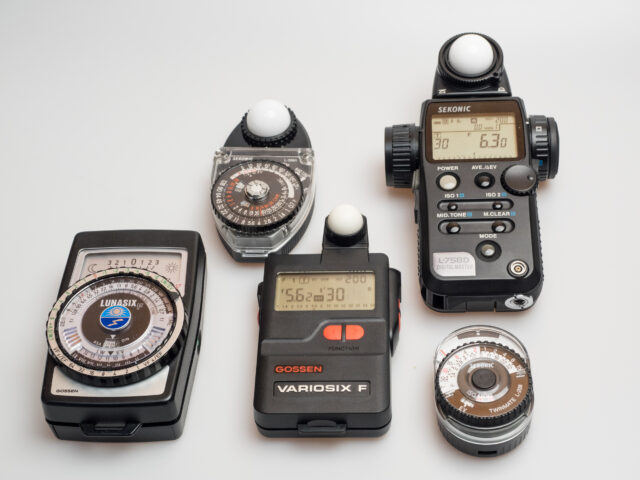
In the second part of this Macfilos mini-series, we look at hand-held light meters. They offer unique options for measuring incident light, and the more modern candidates are real high-tech miracles. Meet the Gossen Lunasix F and Variosix F as well as Sekonic’s L-398A, L-208 Twinmate, and L-758D in this review of five hand-held light meters.
Without a doubt, attachable light meters are convenient for their smallness and convenience. You can leave them on the accessory shoe of your camera while you’re out and about. However, they are limited in their abilities. Hand-held meters offer far greater possibilities. Countless different models have been made over the decades, and some manufacturers such as Weston became legendary. It’s also noteworthy that both Minolta and Kodak used their expertise in the science of exposure for designing light meters.
Hand-held light meters have dominated the market for a good reason. They are the most versatile devices for measuring light, and many of them can handle both ambient and flash light. The market has been shrinking for many years now, but you can still buy quite a selection of new hand-held meters. The most prominent manufacturers are Gossen (German) and Sekonic (Japan) and both have a longstanding reputation in this field. As our review of five hand-held light meters is showing, this reputation is warranted.
Measure the real light
A hand-held light meter gives you extended possibilities mainly because it can measure the actual light and not just what is reflected from your subject. Even the best TTL metering is based on the light that is shining back into the camera, and that’s great in many instances. But sometimes the system is fooled: Some subjects are not doing you the pleasure of having a brightness distribution that averages to 18% grey. You all know the examples of the black steam locomotive or the snowman in a white environment.
Instead of correcting your exposure or working with the histogram, you can use hand-held light meters to measure the incident light. That is, you measure from your subject into the light. The brightness of what you want to shoot plays no role. This is a technique that has gone somewhat out of fashion, but it is still very helpful. I can only encourage you to try it out. It will teach you very quickly to estimate the quantity of light in a given situation.
Furthermore, a professional exposure meter helps you to get more accuracy in stationary work with studio lights and multiple flash use. This is where dedicated exposure meters were always used to calculate and tune the different sources of light. The emergence of powerful and high-quality LED light sources and the possibility to control your result via tethered shooting might have made things easier, but complex flash situations still are the territory of the most advanced light meters. I will not, however, go into the details because I am not really competent in this field and would rather concentrate on a practical review of five hand-held light meters.
Attachable or hand-held?
The question if you prefer an attachable or a hand-held exposure meter is primarily answered by the method of use. For incident light measuring, only a hand-held meter makes sense. You will have to go to your subject and take your reading there (or at an equivalent location). With a device that is attached to your camera, you will always measure in the direction facing your subject (or a replacement such as a grey card). But you can also use the hand-held meter for reflected light measuring so they are more versatile by principle. On the other hand, you need to carry an extra device.
As to attachable versus hand-held, I am not giving a definitive judgement because I personally like both types of meter. For reportage or snapshot photography, the attached meter gives you more speed and good reliability once you have a secure feeling for its angle of measurement (often it corresponds roughly with the 90mm focal length that is shown in many rangefinders). For more considerate work or under well-controlled circumstances, the hand-held meter with its incident light measuring abilities is the superior tool. And most of these meters are quite handy to carry in your bag, so never mind the extra weight unless every gram has to count.
Get the details – five solutions that might fit you
In the review section, we will look at five different hand-held light meters. They reflect the technology from several decades, but all of them are eminently usable to this day. The latest iterations of light meters have a smartphone-like display and some even feature touch control. However, I have not had the opportunity to work with one of these devices so far.
The main source for the following reviews is my own experience of course, but also the instruction manuals were often useful. Both Sekonic and Gossen offer a large number of manuals, even for long-discontinued products, on their websites. This deserves special praise. A further great resource is camera-wiki.org where I got some of the production dates and a few additional bits and pieces. Without them, the following review of five hand-held light meters would not have been possible.
Gossen Lunasix F
Gossen Lunasix – this name alone made professional photographers and ambitious amateurs click their tongues. That was a long time ago; the Erlangen-based company established the excellent reputation of the Gossen light meters in the 50s and 60s and that reputation persists to this day. At that time, a built-in light meter in the camera was the exception. Now it’s a standard of course, but Gossen has stood its ground, and both in the company’s history and for us users, the Lunasix F takes on a very special role. It has an unusual operating principle — and it was the last professional light meter with an analogue pointer instrument and without microprocessors that Gossen ever produced.
The Lunasix F, first introduced in 1981 (as a variant of the then top model Profisix), has only the good name in common with the earlier Lunasix. Other than these, the Lunasix F uses electronic circuits and works with a CdS measuring cell. It also masters flash metering and could be upgraded with accessories, for example for spot metering and even for use under the enlarger in the darkroom. Only a few years after the introduction of the Lunasix F, the triumphant advance of digital hand-held light meters began, which were then quickly considered far superior (not always rightly so).
Perhaps the best aspect of the Lunasix F is that it works with so-called zero-point metering. Whether with incident light metering or reflected light metering, the pointer will always swing out. The user then turns the large setting wheel — which is also a calculating disc — until the pointer stops at zero in the middle. This effectively rules out measurement errors due to lower mechanical accuracy at the ends of the scale, and operation is absolutely intuitive. And even better: if you already know that you want to overexpose by one aperture, you simply set the wheel so that the pointer stops at +1. At the top of the scale, you can see all the appropriate time/aperture combinations, while at the bottom are the EV readings. There also is a scale for the zone system.
In practical use, the Lunasix F is a good companion. It is not super small and light as a feather, but not too bulky either. Above all, it is very easy to read. With just two buttons, you can switch from memory to continuous light measurement and from flash to ambient light. Correction factors, for example for filters, are easy to set, and a red reminder icon reminds you of it. Not to be underestimated, moreover, is the fact that the pointer makes it easy to determine the contrast range of a subject, as long as it does not exceed six f-stops. Of course, by today’s standards, that’s narrow.
The fact that hand exposure meters with pointer readings are still relevant today is shown by the two Sekonic products that I will describe in more detail below. But none is as easy to use for continuous light metering as the Lunasix F. Those who own a well-calibrated model or can find an affordable one will perhaps enjoy it for decades to come: Rarely is retro as modern as with the superbly built Lunasix F with its indestructible leather case.
Sekonic L-398A Studio Deluxe III
Who would have thought that such a device still existed? The Sekonic L-398A not only looks retro, but it actually is. When the manufacturer celebrated its 70th anniversary in 2021, it was no coincidence that they chose precisely this light meter as the basis for a special anniversary model. Although it has not been around since 1951, according to Camerawiki it is based directly on the L-28, which was first introduced in 1957. Since then, of course, it has been updated several times, but the basic functions have remained the same to this day. The current version is called Sekonic L-398A III Studio Deluxe and has been available in its current form since 2006.
In the past, this light meter series was also called “Director”, and this as well as the “Studio Deluxe” indicates the main purposes of these light meters: They are best suited for work on the film set or in the photo studio. These living fossils do not deal with flash, they can measure only continuous light. And their measuring range, or more precisely the technology used, makes them more suitable for incident light metering than for reflected light metering; and where the illumination is at least decent. Like on a film set or in a studio.
Because here’s the thing: the L-398 operates without a battery – the way light meters have worked for many years. Traditionally, these used a measuring cell made of selenium, which converts light into electrical current and produces a pointer movement. Since 2006 and the introduction of version III, the selenium measuring cell in the classical Sekonic meter is also history, but it still doesn’t need a battery. Special technology makes it possible — at the price that amplification from the battery is of course not available in low light.
In use, the Sekonic L-398A is somewhat special. The pointer deflection stands for a measured value in the American unit footcandle (lumen per square foot, lm/ft²). You then set this value on the calculator disc (which really has no other function) and can then read off your time/aperture combinations.
With a little practice, this is quick, but a certain probability of error remains compared to the direct reading of an EV value or a time-aperture combination; and the results are less reproducible. Nevertheless, it is possible to work practically with this coelacanth of light meters. The biggest limitation is that for incident light it starts at only EV 4 and even for reflected light only at EV 9. So the Sekonic classic is not really suitable for dim light.
Nevertheless, it is fun to work with this somewhat old-fashioned device. The swivelling head gives it flexibility, and the plug-in slides (purchased separately) allow direct reading of aperture values (once you have understood the principle). Care should be taken with credit cards and electronic devices near the L-398A. The strong magnet built into this unit could cause damage.
All in all, the Sekonic Studio Deluxe L-398A III is an interesting tool. The fact that it works without any battery makes this light meter unique. If you have got the knack of it and there is enough light, you can work well with it. All in all, however, it is more a product for specialists.
Sekonic L-208 Twinmate
If you pick up the Sekonic L-208 Twinmate for the first time, you might ask yourself whether you can take this small and featherweight piece at all seriously. In fact, this light meter is so small and light that you can even put it on the camera’s hot shoe with the accompanying adapter! However, I would advise using it hand-held.
As small as the Sekonic Twinmate is, it is all grown up in its functions. With the exception of flash metering, it can handle everything you would expect. A small opaque hemisphere can be slid over the metering cell, which then enables full incident light metering. Alternatively, reflected light metering is of course also possible. As is well known, each method has its advantages and disadvantages.
The metering cell is mounted in a fixed position on this small device, which is not quite as convenient in the studio, for object photography or repro work, but then again the Twinmate is so small that you can also point it as a whole in any direction. There is only one thing to watch out for — make sure that a finger doesn’t accidentally cover the measuring cell.
You will hardly need an instruction manual for the small Sekonic. Simply press the measuring button, then the exposure is saved and the needle stops. In the second step, align the green pointer with the needle and you can read off all the applicable time/aperture combinations. The only thing to note is that the hemisphere called Lumisphere must be pushed to the side for object metering.
The Twinmate’s biggest advantage is certainly its small size and low weight. There’s actually no excuse not to take it with you in your photo bag, and it’s pretty much capable of any photographic task as long as there’s no flash involved. In addition, it has very good measuring accuracy and is easy to use. All in all, a no-brainer.
Gossen Variosix F
The Gossen Variosix F (in the USA it was offered as the Lunastar-F) was launched in 1990 and was the flagship of the German manufacturer at that time. It was radically different from the company’s previous products — without an indicator needle and without an analogue dial and calculating disc, but with a large and clear LC display. It mastered all measuring methods, and with its optional spot attachment, it was also particularly well equipped for reflected light measurement.
With two pairs of buttons, you can switch easily between the functions and your shutter speed and aperture value combinations. Within a short time, you will master this very intuitively, and even somewhat complicated tasks such as measuring your subject’s contrast range are quite easy to handle. The additional display on an analogue aperture value scale also helps here.
What bothers me, however, is the subdivision of the full aperture values into decimals. For example, aperture 5.65 means exactly the middle between f/5.6 and f/8. For me, 6.8 (as all modern cameras actually display) would be much more intuitive, especially since many lenses have half or third aperture values.
A great advantage of the Variosix F is that it can automatically determine correction factors, such as those that have to be taken into account when using a filter. Also very practical is the function that calculates the ratio of the different light sources when using a flash setup. In addition, the Variosix F has a very high-quality finish. Mine needed a repair after more than 15 years, which Gossen carried out at a fair price. I have no doubt that the Variosix F will serve me well for many more years.
Production of the Variosix F models has long since ceased, although they are actually still up to date even in 2022. When buying second-hand, make sure that the second incident light dome for the range between EV 18 and EV 23 is also included. The direct successor, Variosix F2, no longer needs this small and easily lost accessory, and it is also slightly better in very low light (lower measuring limit EV -2.5 instead of -2).
To this day, many Gossen light meters cannot deny their kinship with the Variosix F, and they have also adopted the excellent operating concept. So if you can find a Variosix F or Variosix F2 at a reasonable price, you can’t really go far wrong. As always, however, I would insist on checking the correct function before buying. You should pay particular attention to whether everything is displayed correctly and that the display has not lost its contrast over the years.
Sekonic L-758D
The Sekonic L-758D is unquestionably the most modern and best-equipped light meter in this review. In fact, it is more like a small computer that can also be used with a corresponding extension to trigger studio flashes for metering via radio (but there is also a connection for a cable). It combines a spot light meter and a device for incident light metering in a single body.
It would be going too far to list all the functions here; it is no coincidence that the manual for the L-758D is almost 70 pages long (here again some words of praise for Sekonic and Gossen who both offer almost all the manuals for their discontinued products for free use on the internet).
Precisely because of the enormous range of functions, it is more of a device for photographers who use it regularly. And via custom functions, certain functions can be switched on and off. That’s not bad at all for keeping a reasonable overview. You can also connect the L-758D to a computer via USB and make further calibrations and settings.
With incident light metering, the metering dome can be used in two different positions — depending on whether you’re photographing a three-dimensional object or a flat object. With 1° spot metering, up to nine values can be stored and then averaged. This is my personal favourite function, because two of my favourite cameras in my photographic career, the Olympus OM-4 and the Canon EOS-3, have exactly this kind of multi-spot metering. If you have a little practice with this metering method, you will very quickly prefer it to any matrix metering, whose calculation methods are always somewhat unfathomable.
The L-758D with its two separate CdS measuring cells works with exemplary precision. The workmanship is also of very high quality, and as a little treat, you can even attach a filter (e.g. for black and white photography) directly to the entrance lens for spot metering. And once you have learned the functions that are relevant to you, it is not even that complicated to operate.


The L-758D was introduced in 2001 and explicitly marketed for digital photography. In the meantime, it has been replaced by its successor, the L-858. The latter is maybe even more attractive with its colour display and touch operation, especially since it already has the radio transmitters for the common flash systems permanently installed. But all this does not change the fact that the Sekonic L-758D is an incredibly powerful handheld exposure meter that leaves nothing to be desired. You just have to get used to it, and that might take a bit longer than for other devices in this review of five hand-held light meters.
Conclusion and Outlook
We have seen in the review that many of these five hand-held light meters are powerful and versatile tools. They make a lot of sense if you take advantage of their wide spectrum of use cases. If you are happy to just measure your subject, you might well be over-equipped with one of the flagships from Gossen or Sekonic. A smaller or older model might do the job as well — but be aware that light meters that are working with a selenium cell will lose their function due to the ageing of their most important component.
Out of the five different meters that I have reviewed here, it is difficult to give one recommendation. I personally like the analogue readout with a needle, and I personally rarely use flash metering. For such more basic needs, the Sekonic Twinmate L-208 is an excellent choice at an attractive price point. For more advanced work, the Variosix F or a modern digital Sekonic light meter are very good solutions.
However, you can also work without a standalone light meter at all. Either you apply the sunny sixteen rule (with some experience, it’s easier than you might expect), or you use a light meter app for your smartphone. In the third and last part of this Macfilos mini-series, we will look at five different apps for iOS. This will give a nice round-up to this review of five hand-held light meters and the review of five attachable light meters in part one of the mini-series.
Again, as to sources (I have, as ever, no commercial interests or connections): The Variosix F and the small Sekonic Twinmate have been with me for many years (the Variosix for decades in fact). The Sekononic L-758D I got on loan from Lichtblick Fotofachgeschäft Konstanz, and the Lunasix F I found online at a fair price at Jo Geier Mint&Rare at Vienna. If you consider buying online, my advice is to purchase from such a reputable dealer. Otherwise, you risk getting a misaligned or broken device.
What are your experiences? Have you ever worked with one of the hand-held light meters that are featured here? Or do you have another favourite? What is your preference: Analogue needle readout or a digital display? Do you actually use incident light metering, or do you find this technique overrated or obsolete?
Decent exposure: The Macfilos mini-series about light measuring solutions
Part 1: Why light meters are useful or necessary and which camera-attachable light meters are recommendable (with reviews of Leicameter MR, Voigtländer VC Meter II, KEKS EM-01, Hedeco Lime One and TTArtisan Two Dials exposure meter. You can read this article in German here on Messsucherwelt.
Part 2: Why incident light metering is better and what other advantages hand-held light meters have (with a review of five hand-held light meters: Gossen’s Lunasix F and Variosix 3 and Sekonic’s Twinmate L-208, Studio Deluxe L-398A, and L-758D (this article; if you prefer to read it in German, find it here on Messsucherwelt).
Part 3: How you can work with a light meter app for your smartphone and which chances and risks you have to know (with reviews of MyLightmeterPro, Lightmate, Lghtmtr, Luxi and Photometer). Plus: The complete overview of all 15 tested solutions (again, there is a German version on Messsucherwelt).
Want to contribute an article to Macfilos? It’s easy. Just click the “Write for Us” button. We’ll help with the writing and guide you through the process.


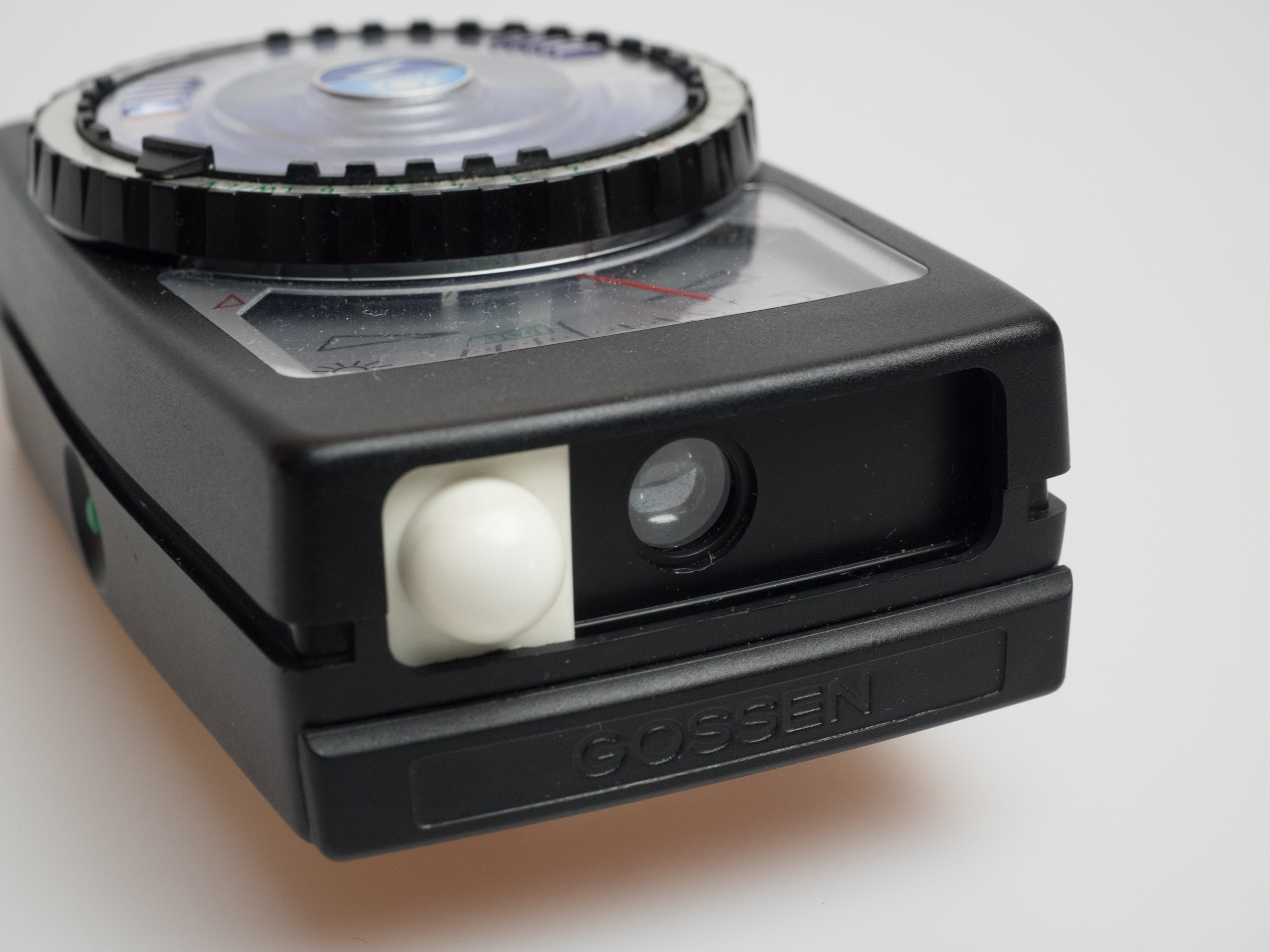
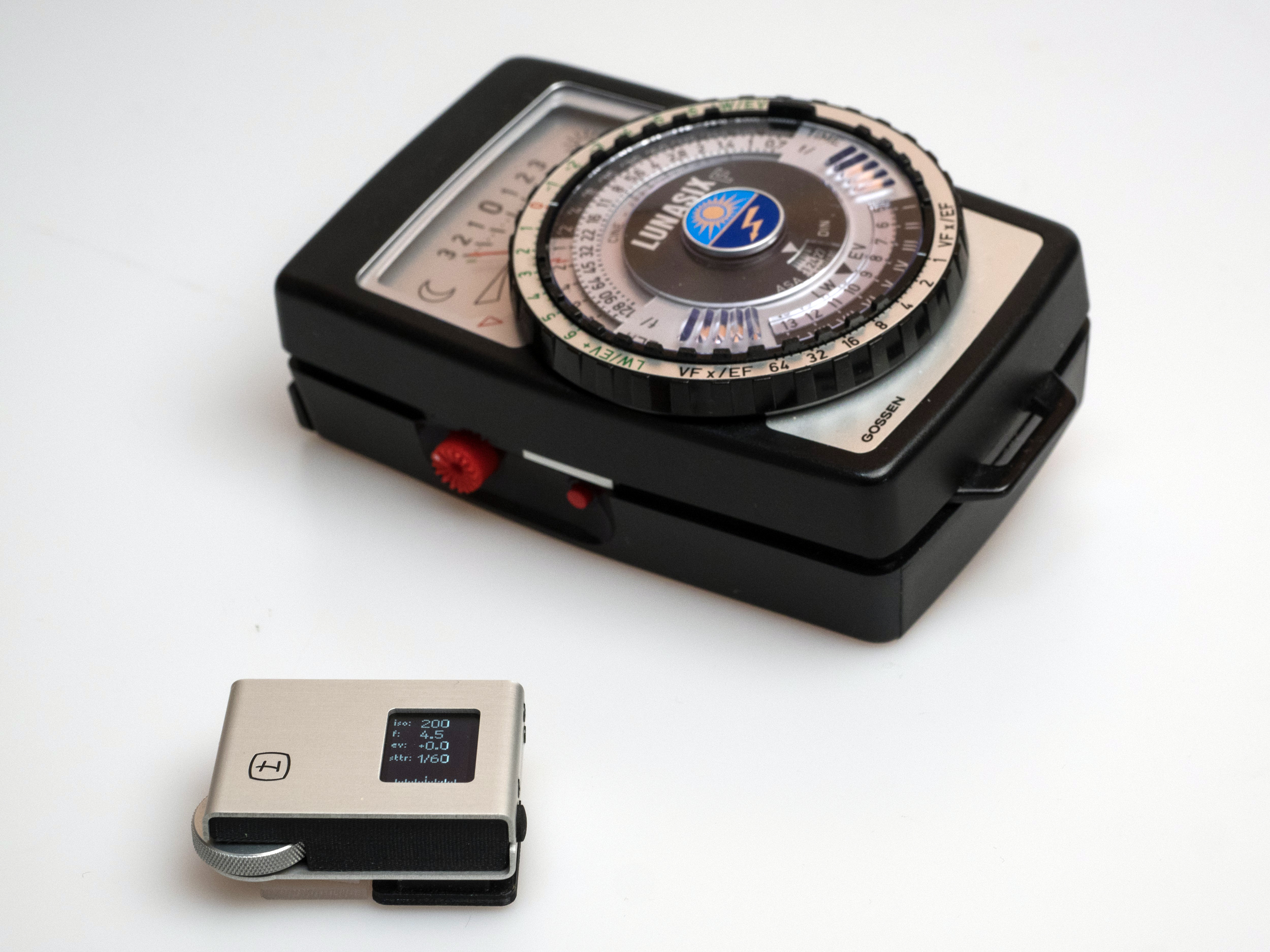
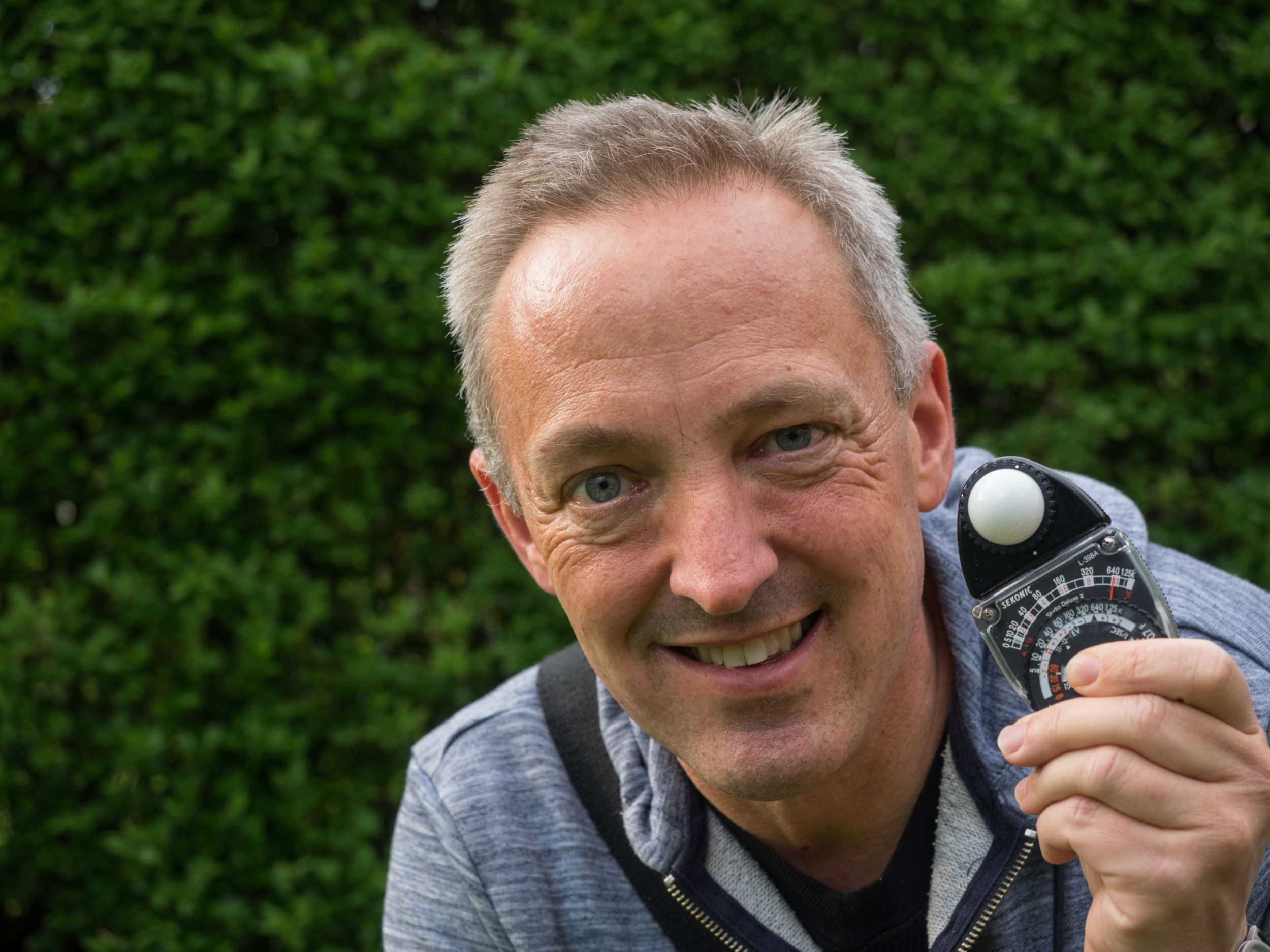
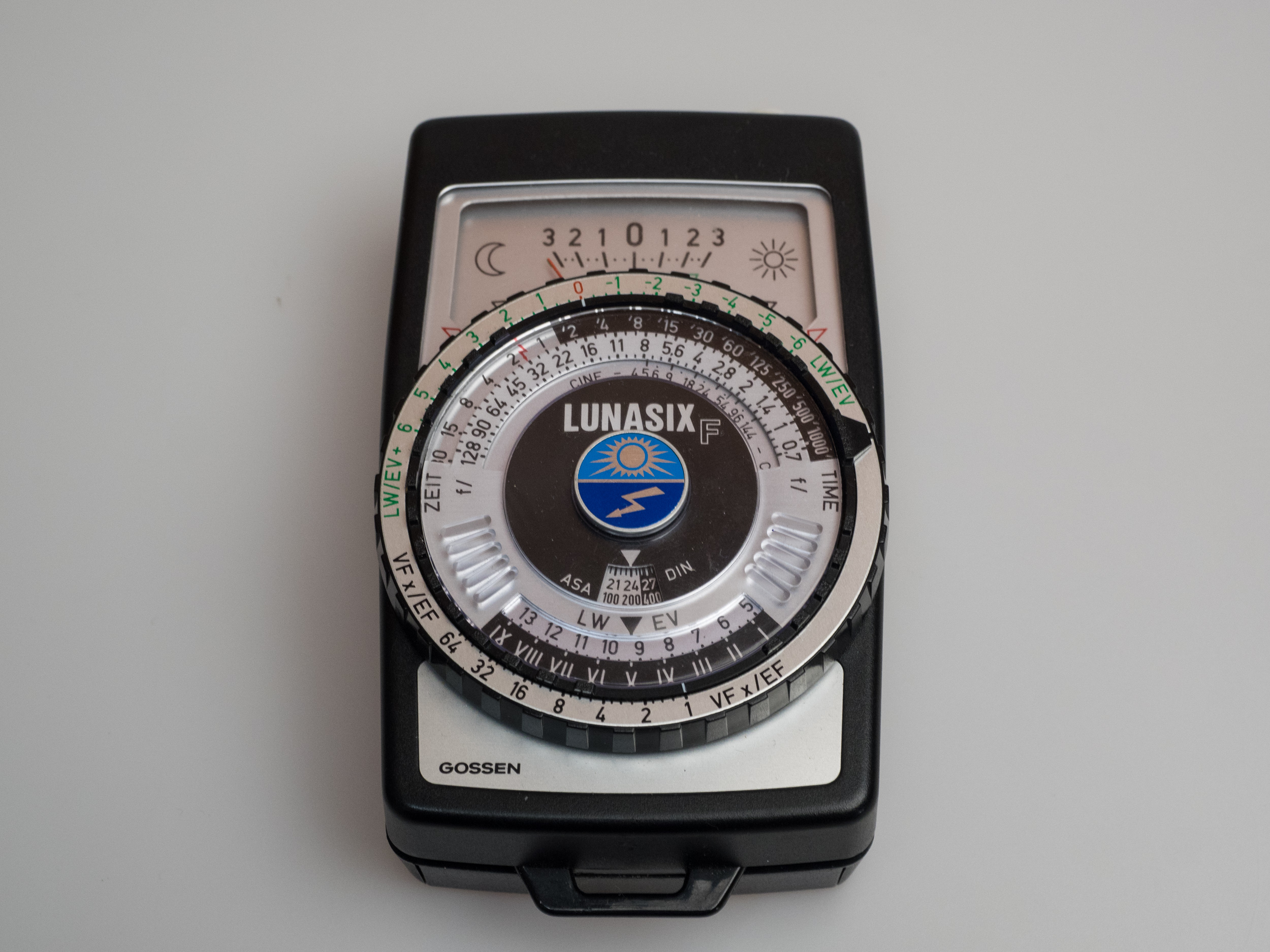
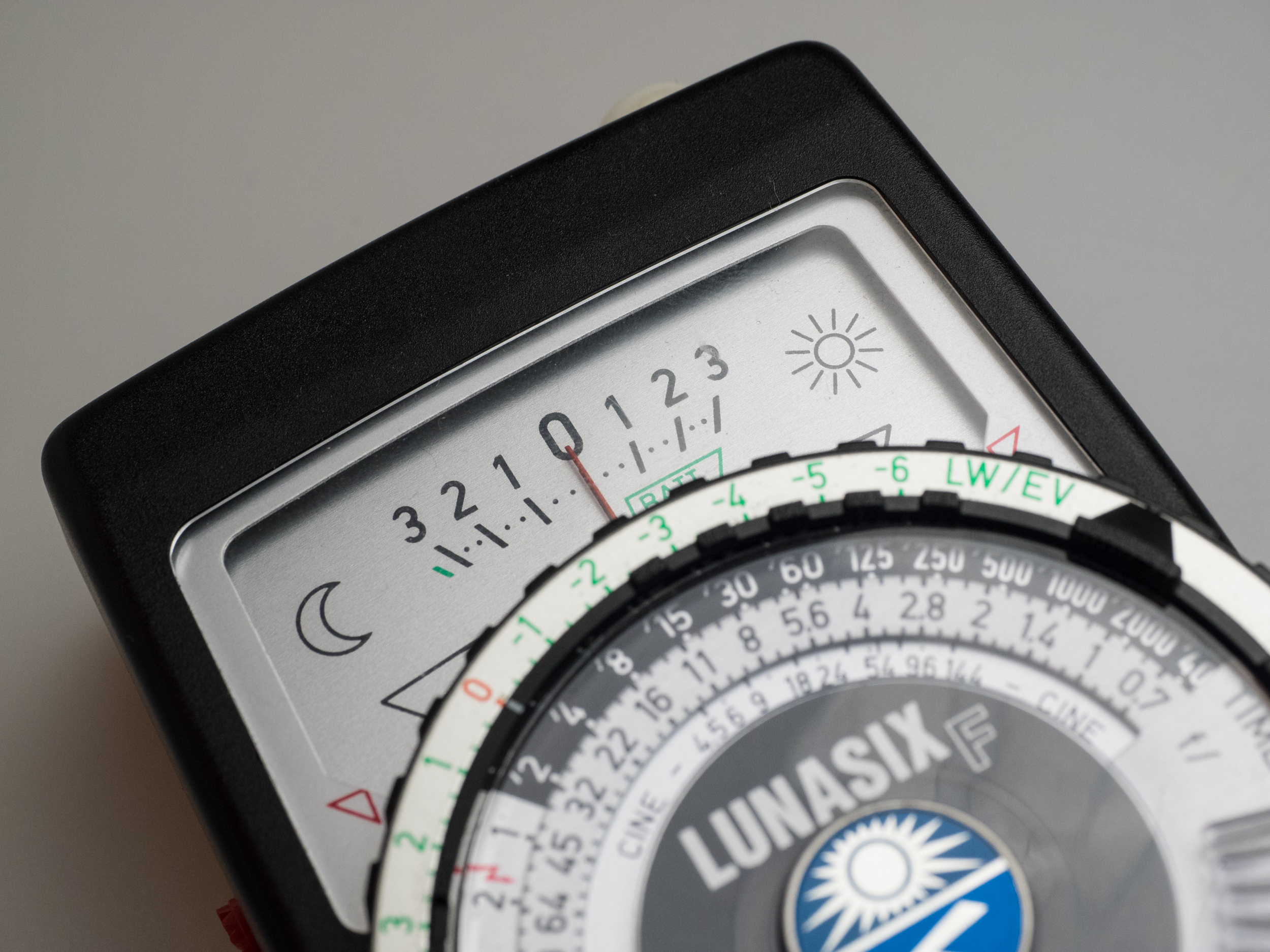
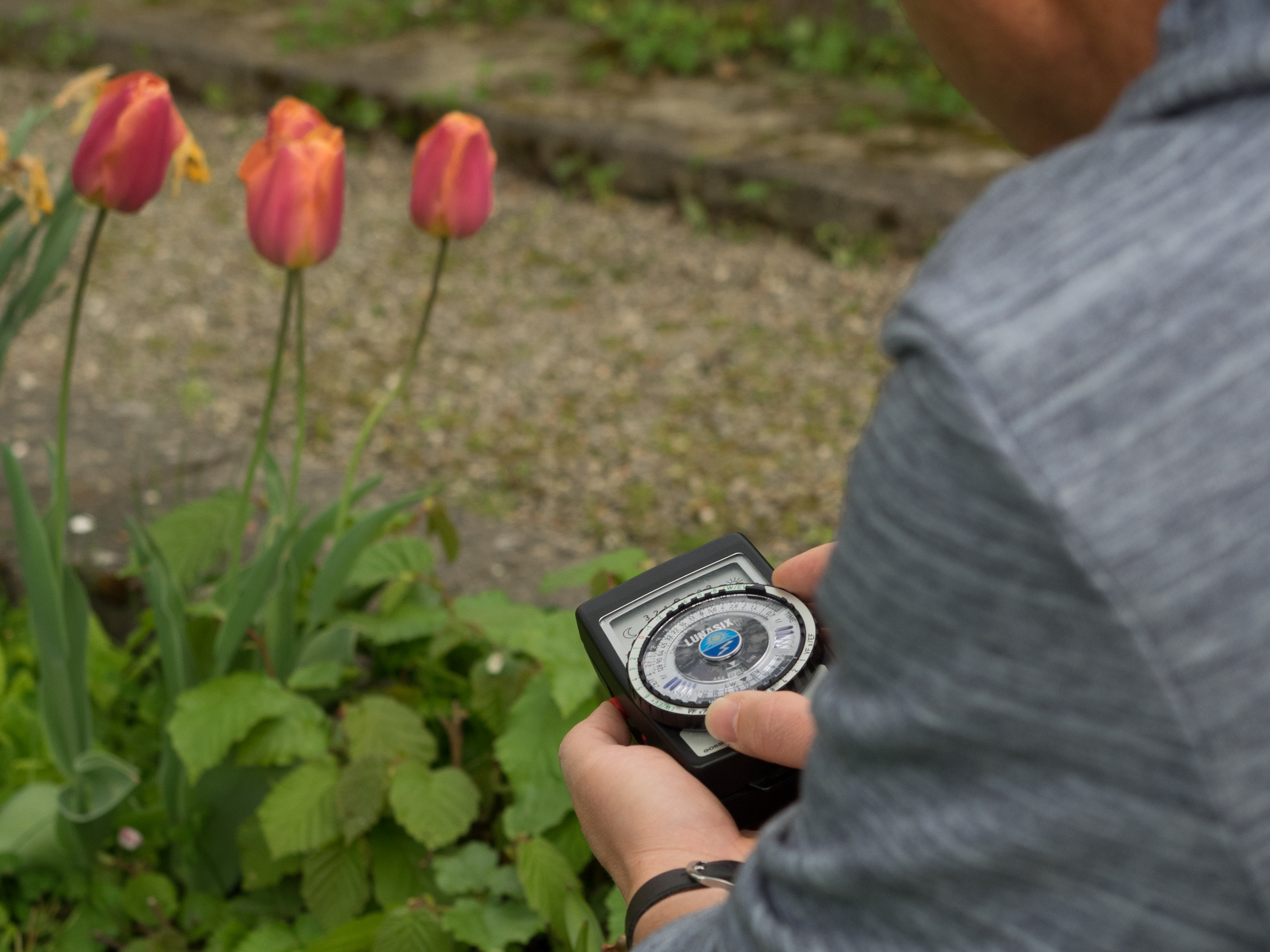
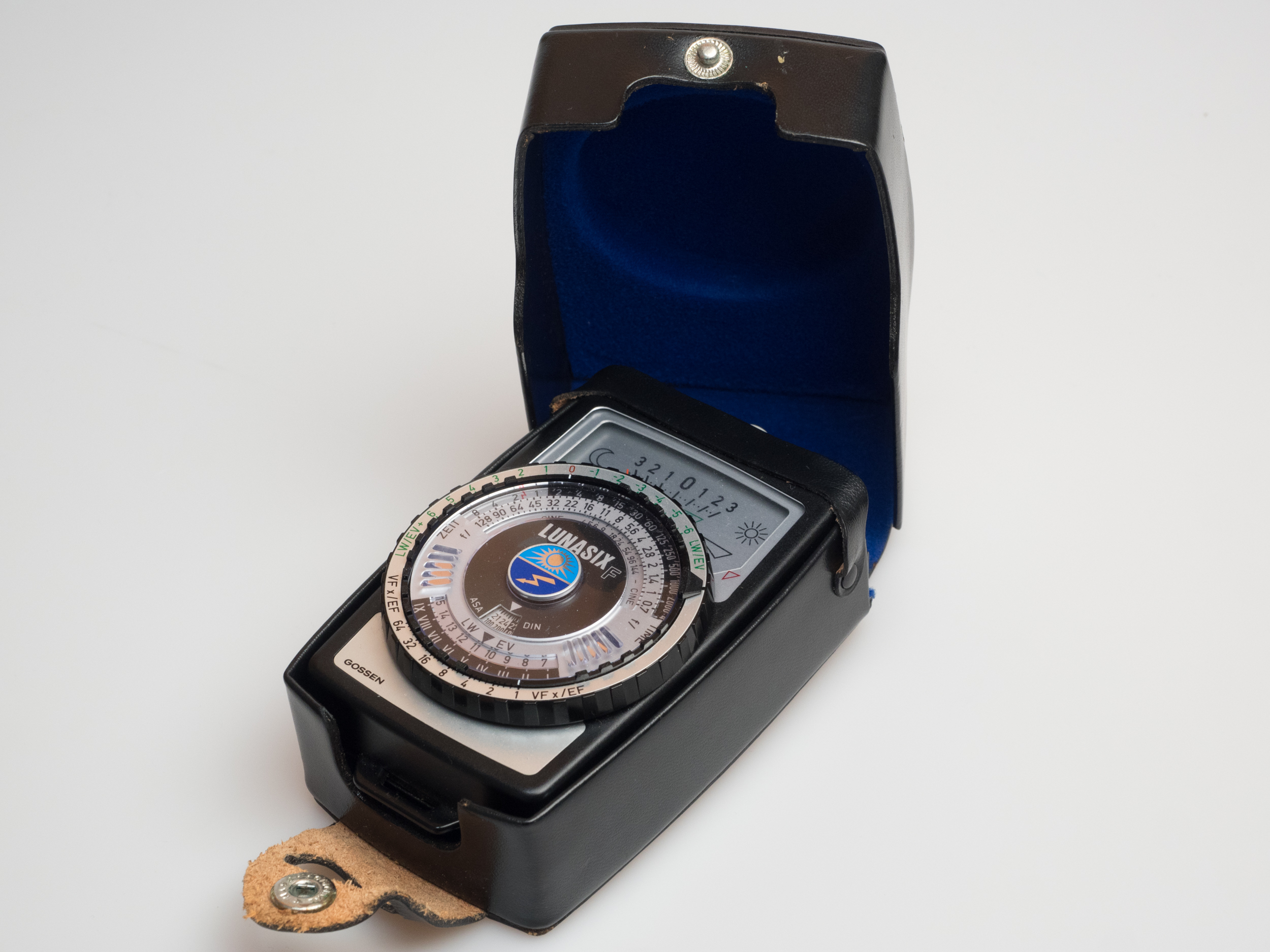

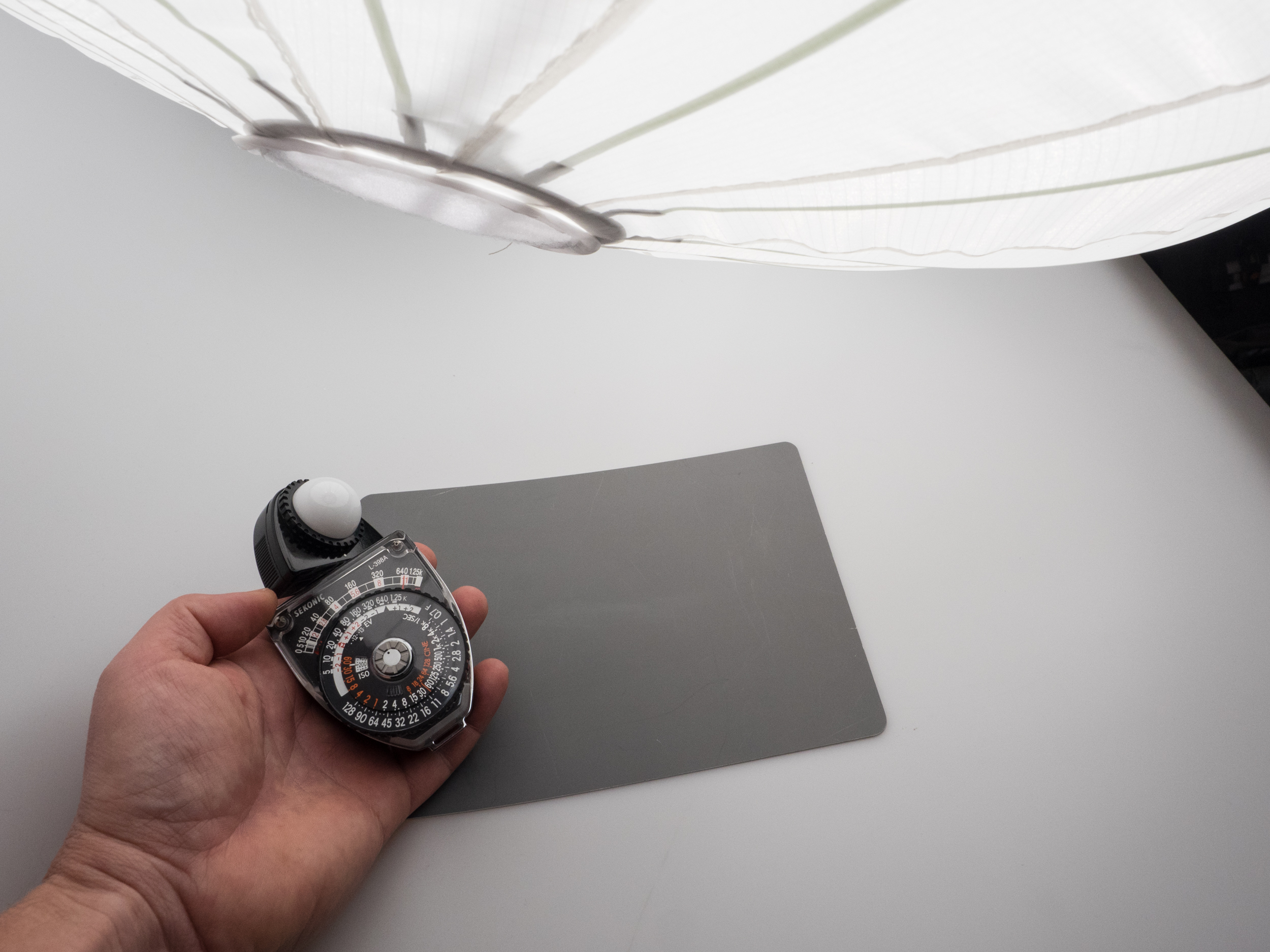
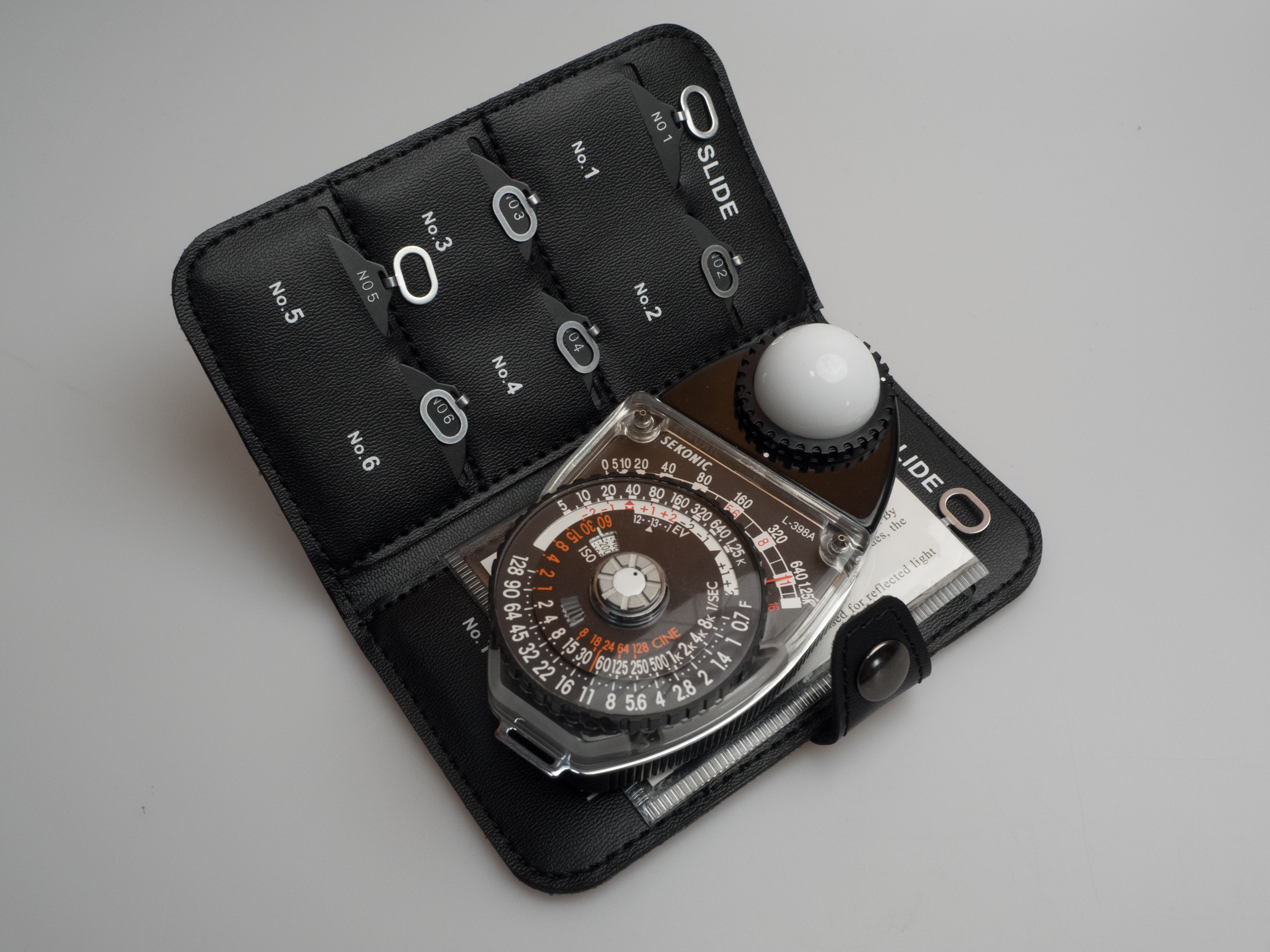
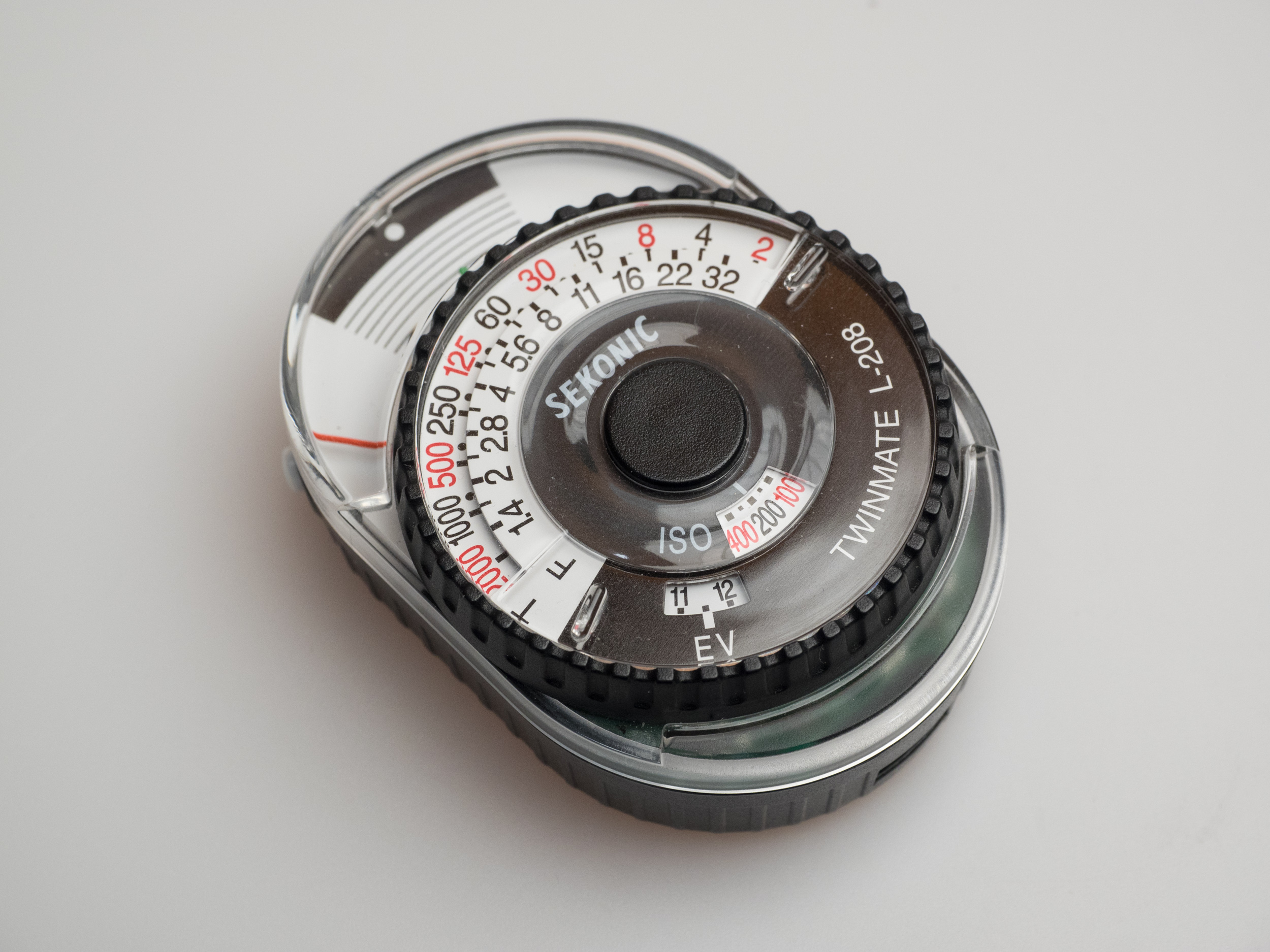
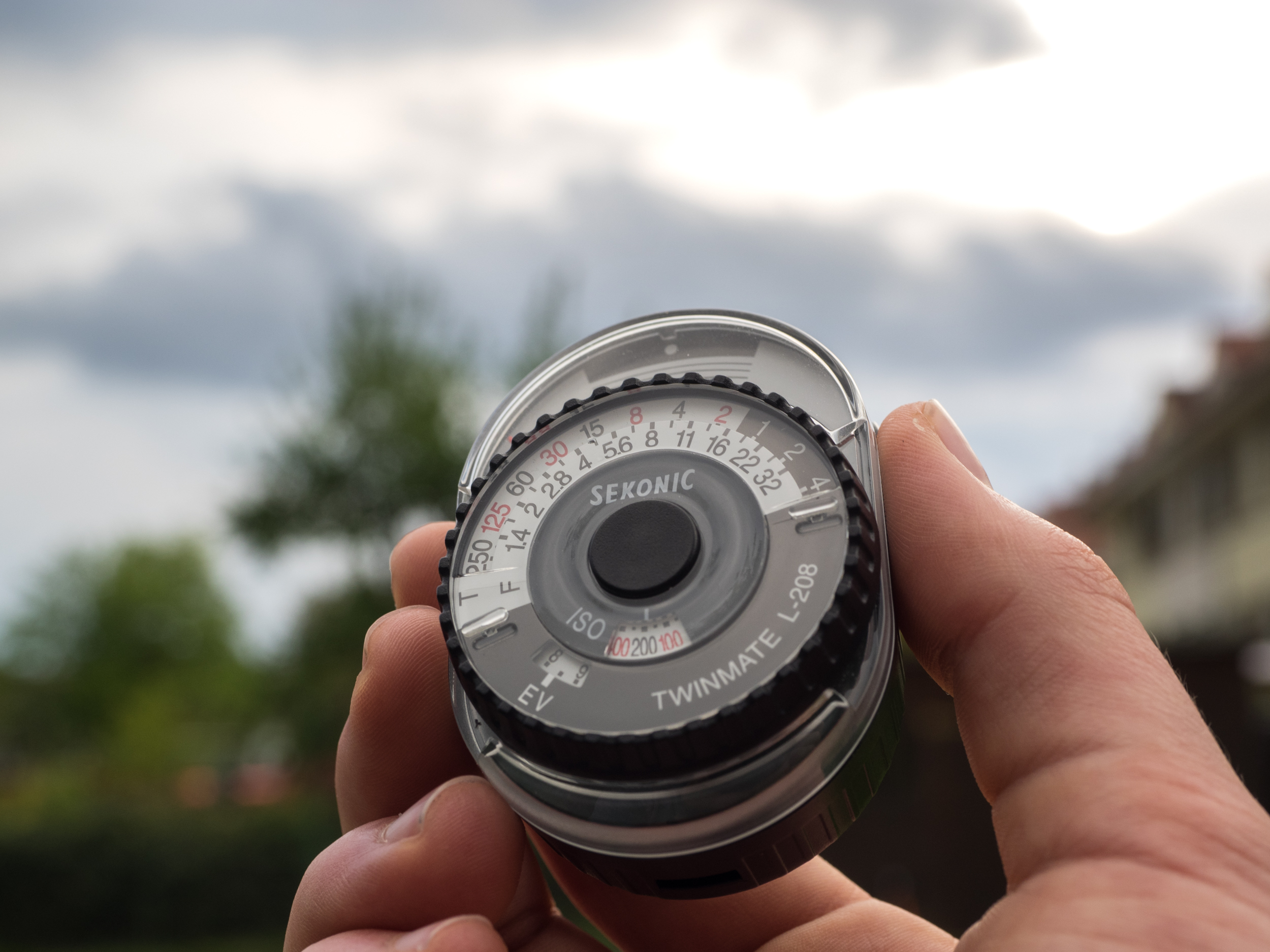
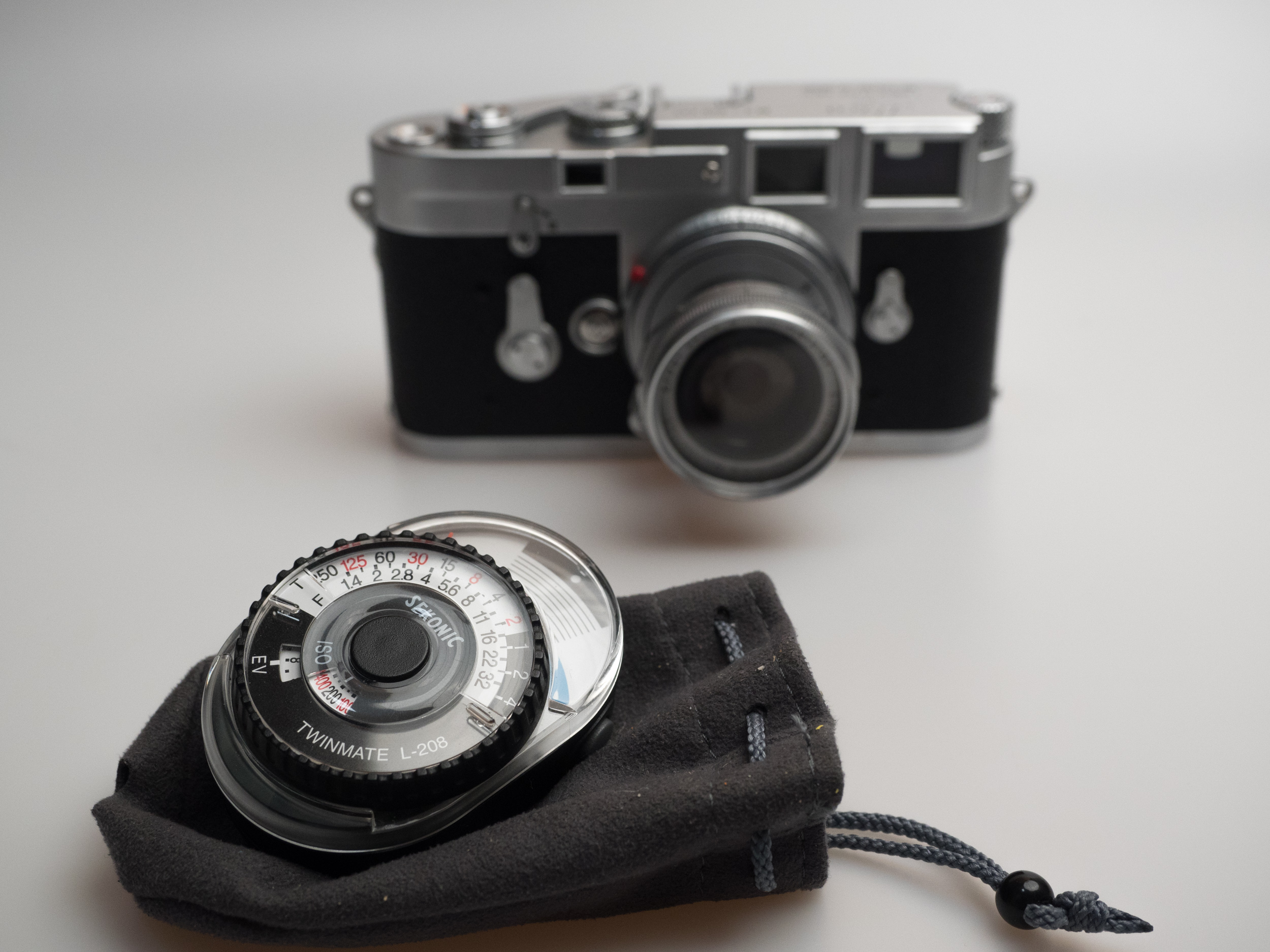
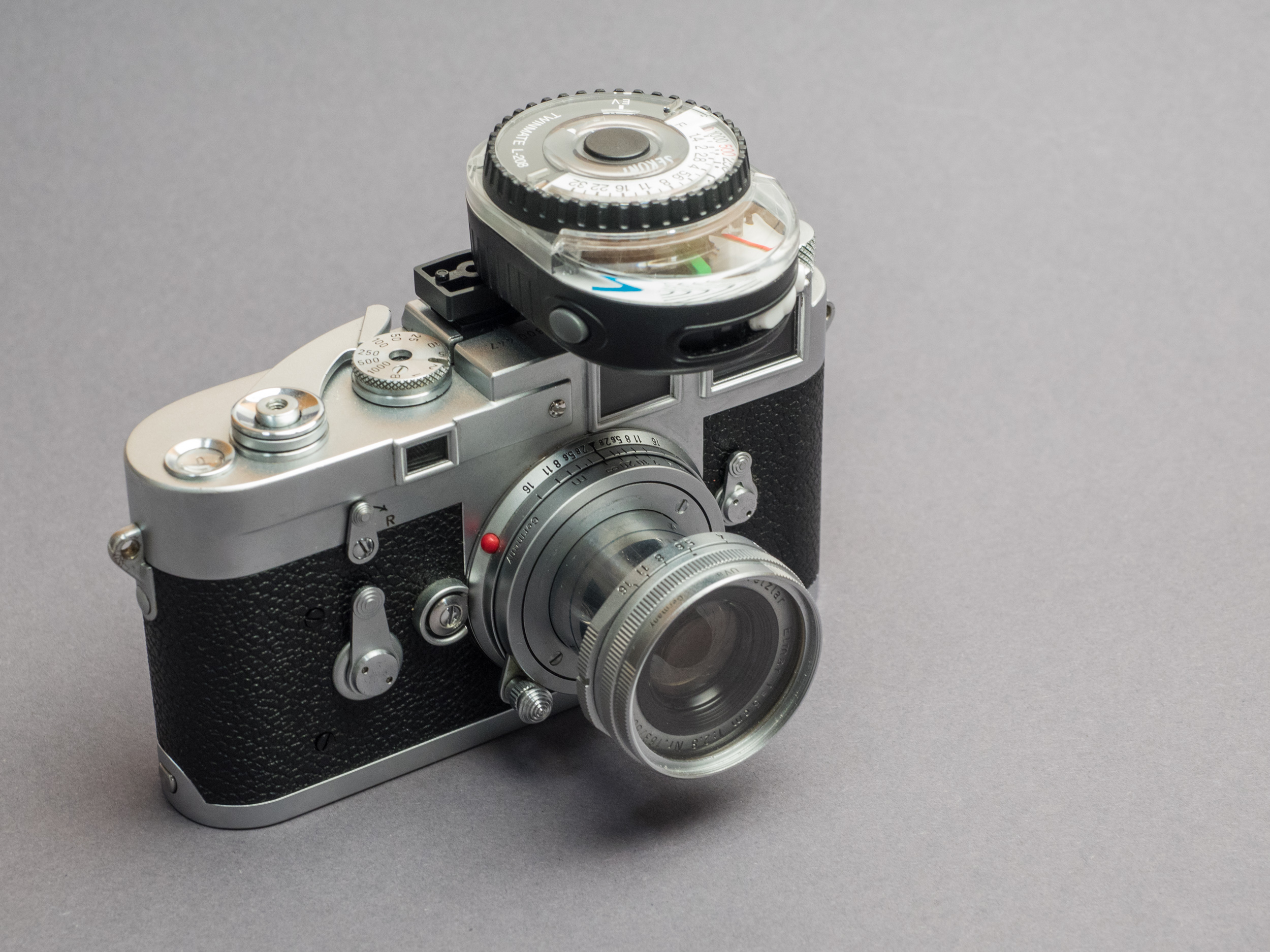
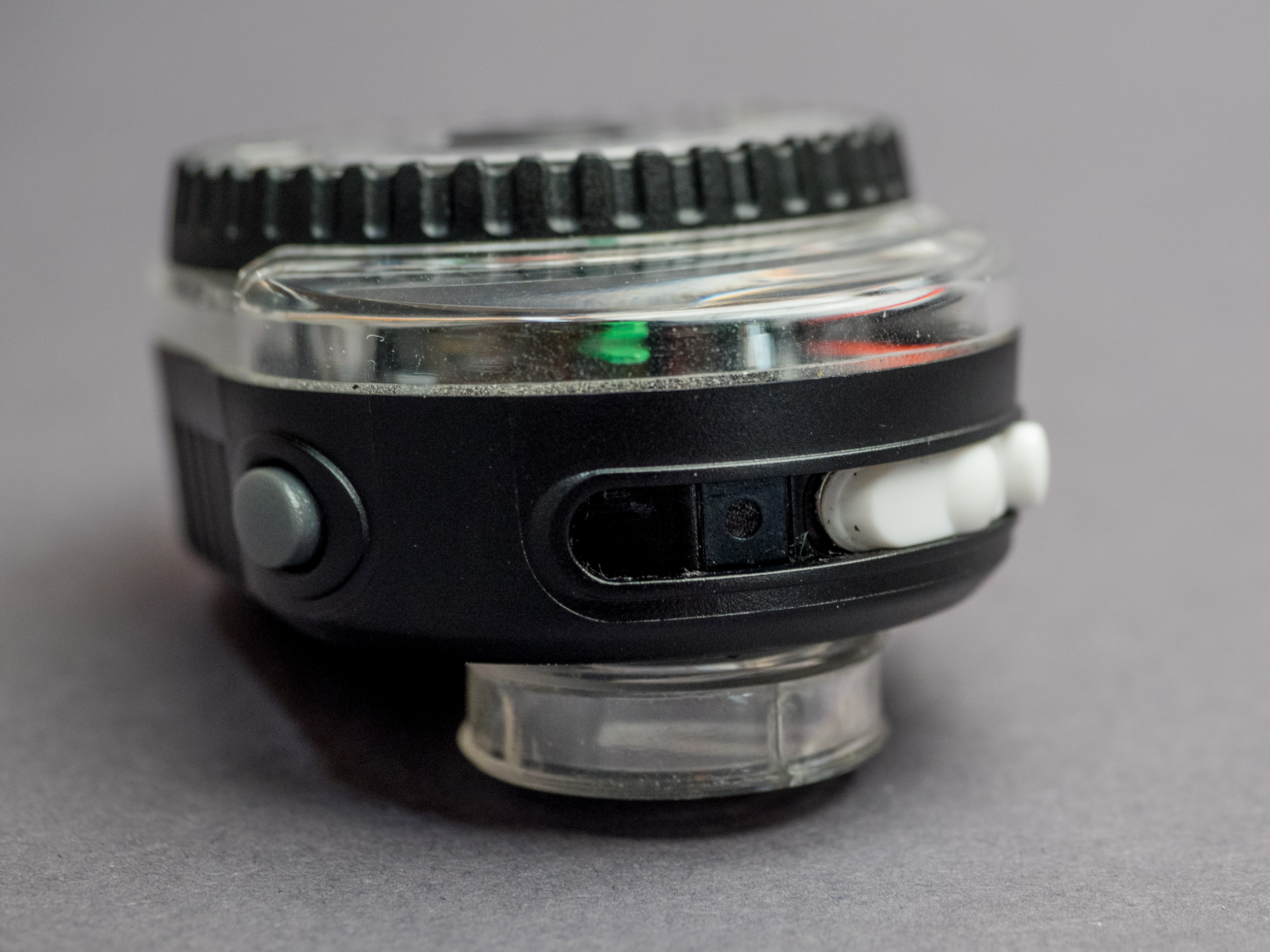
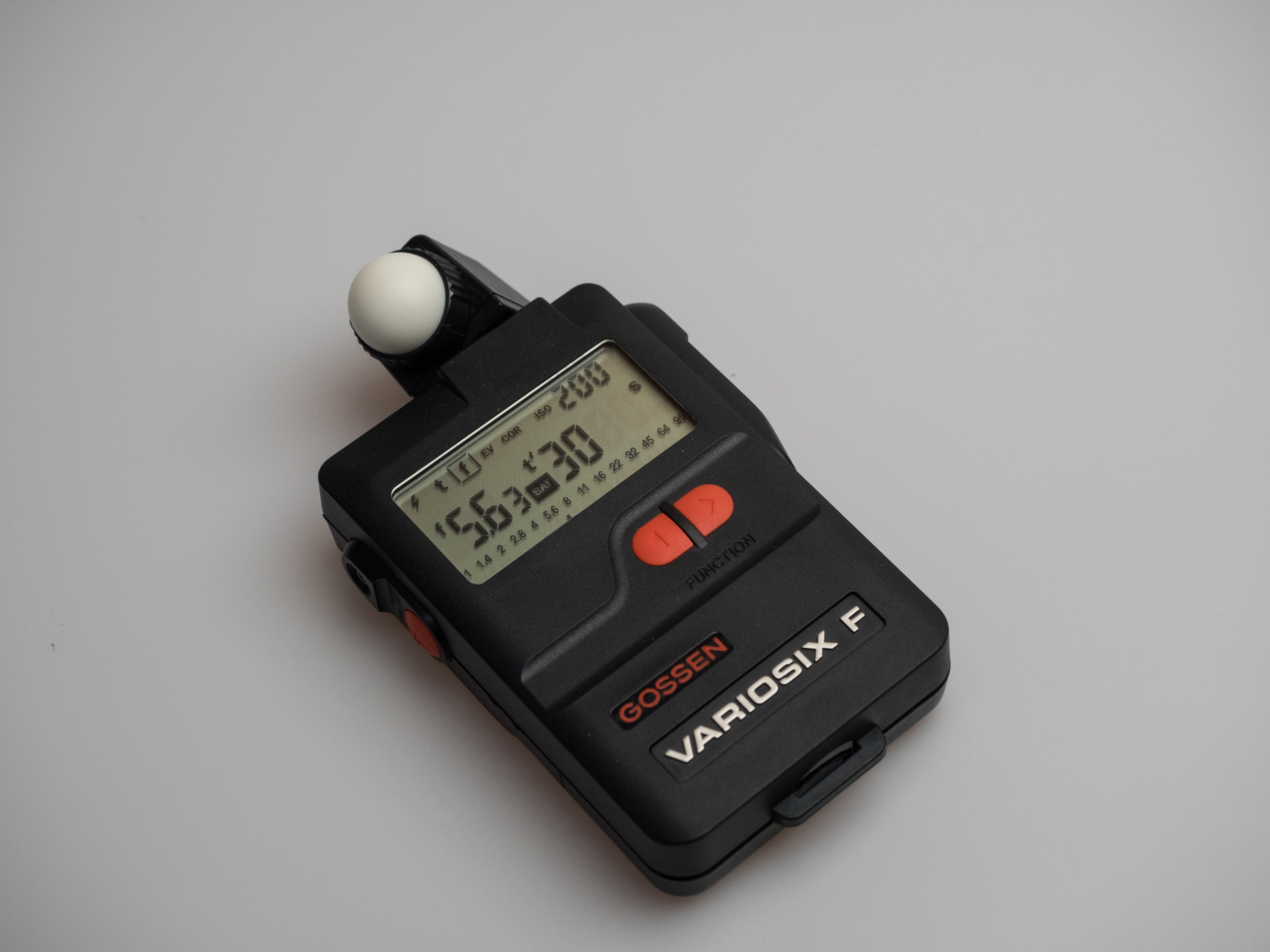
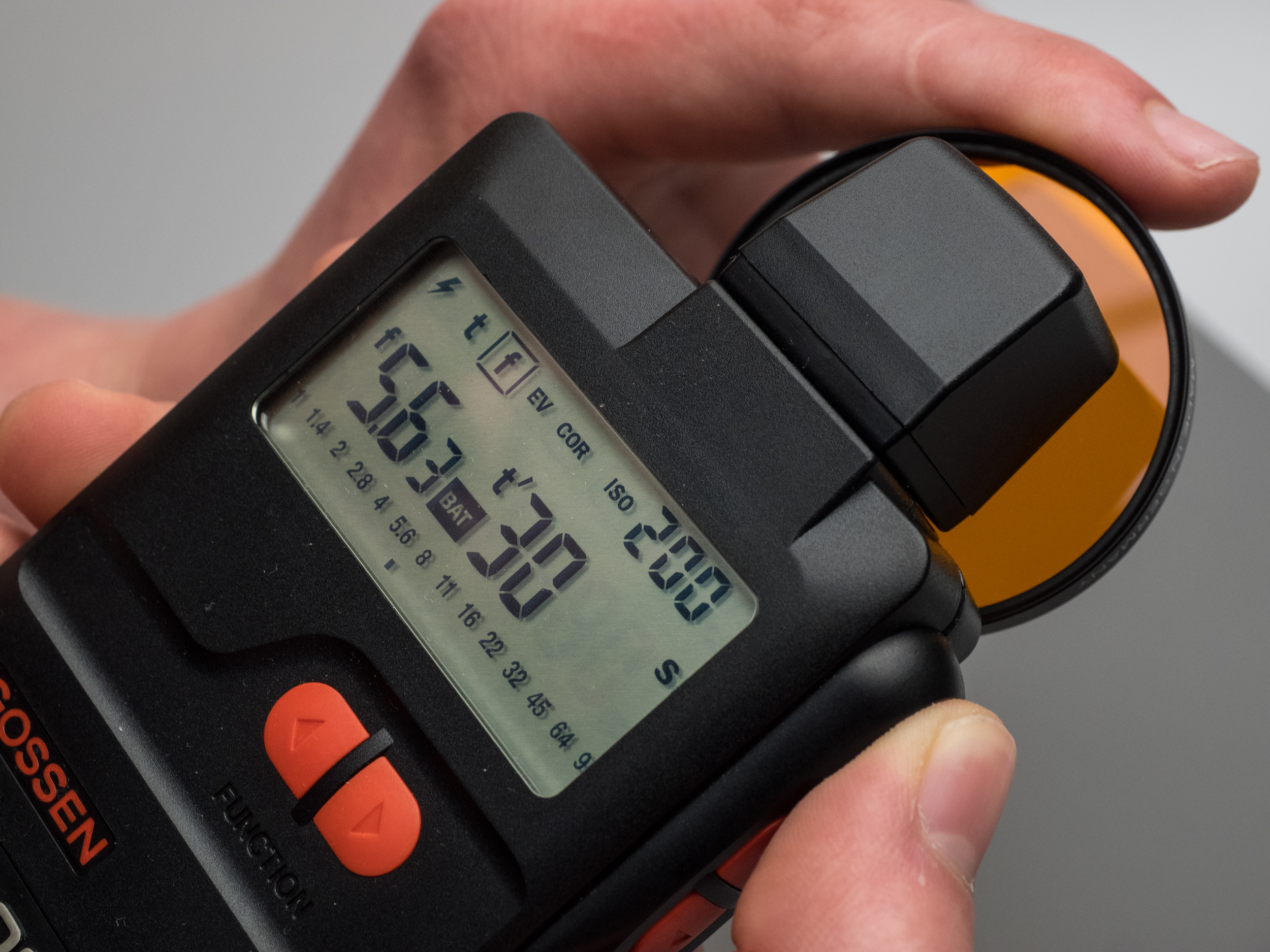
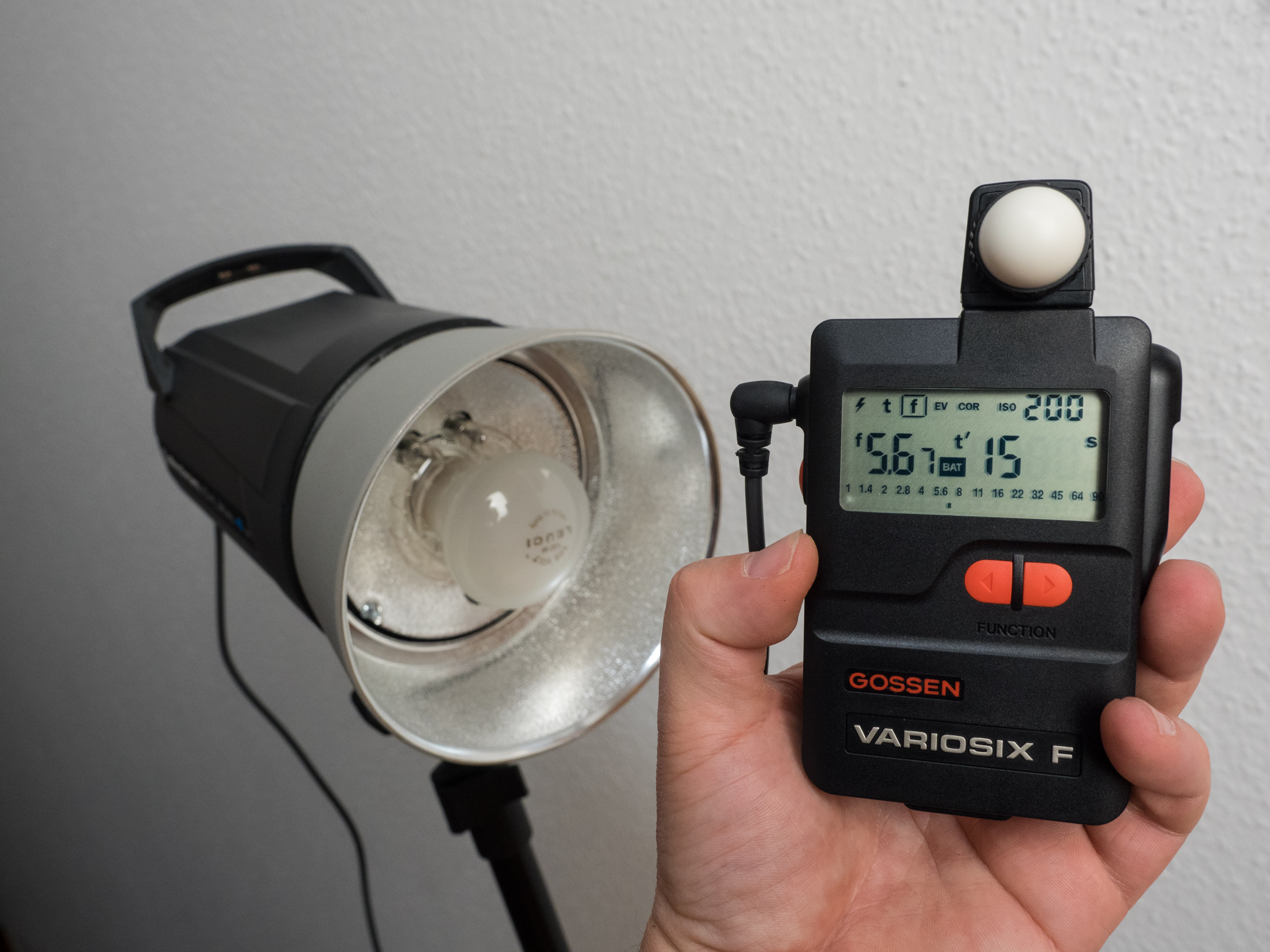
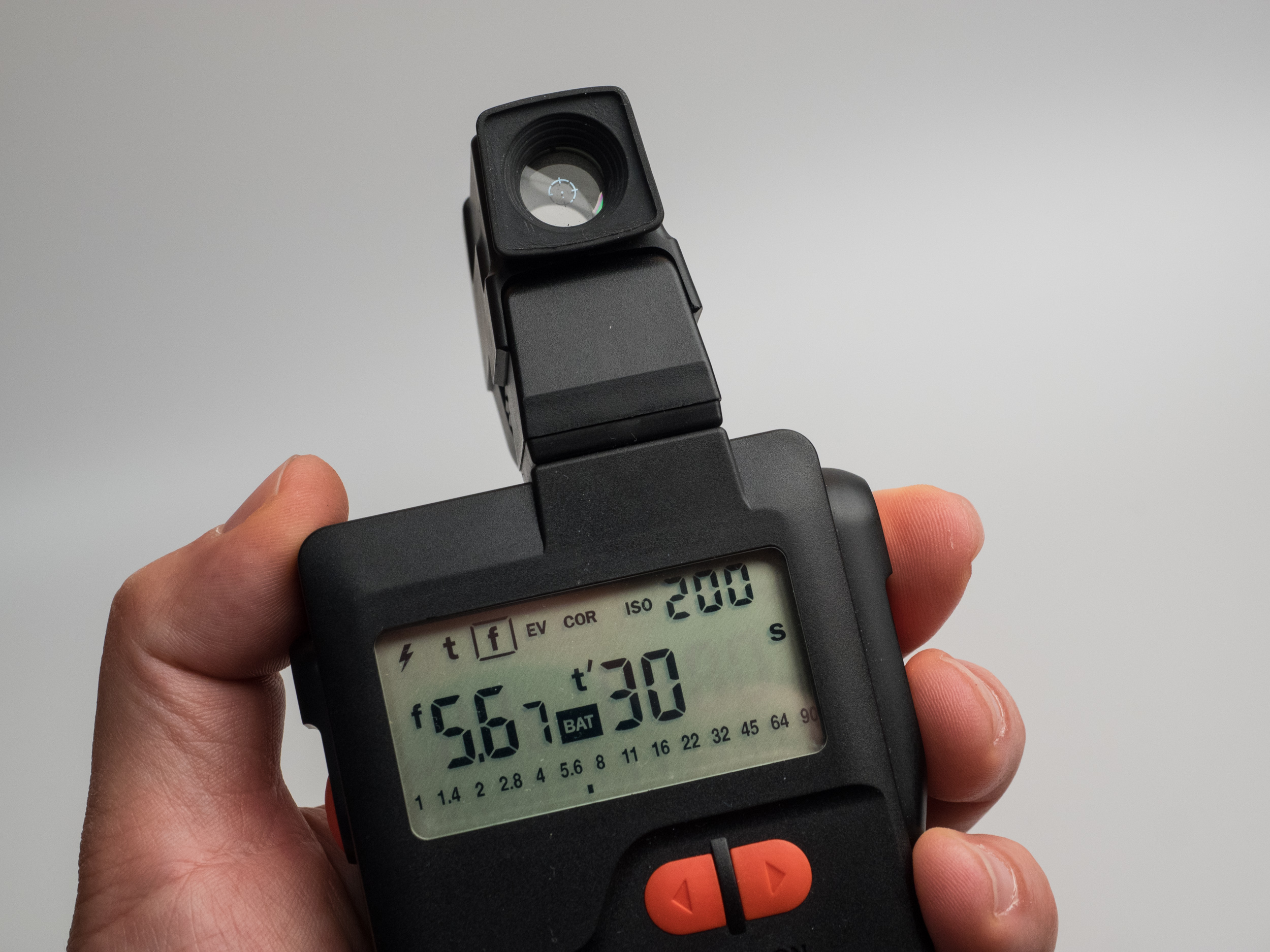
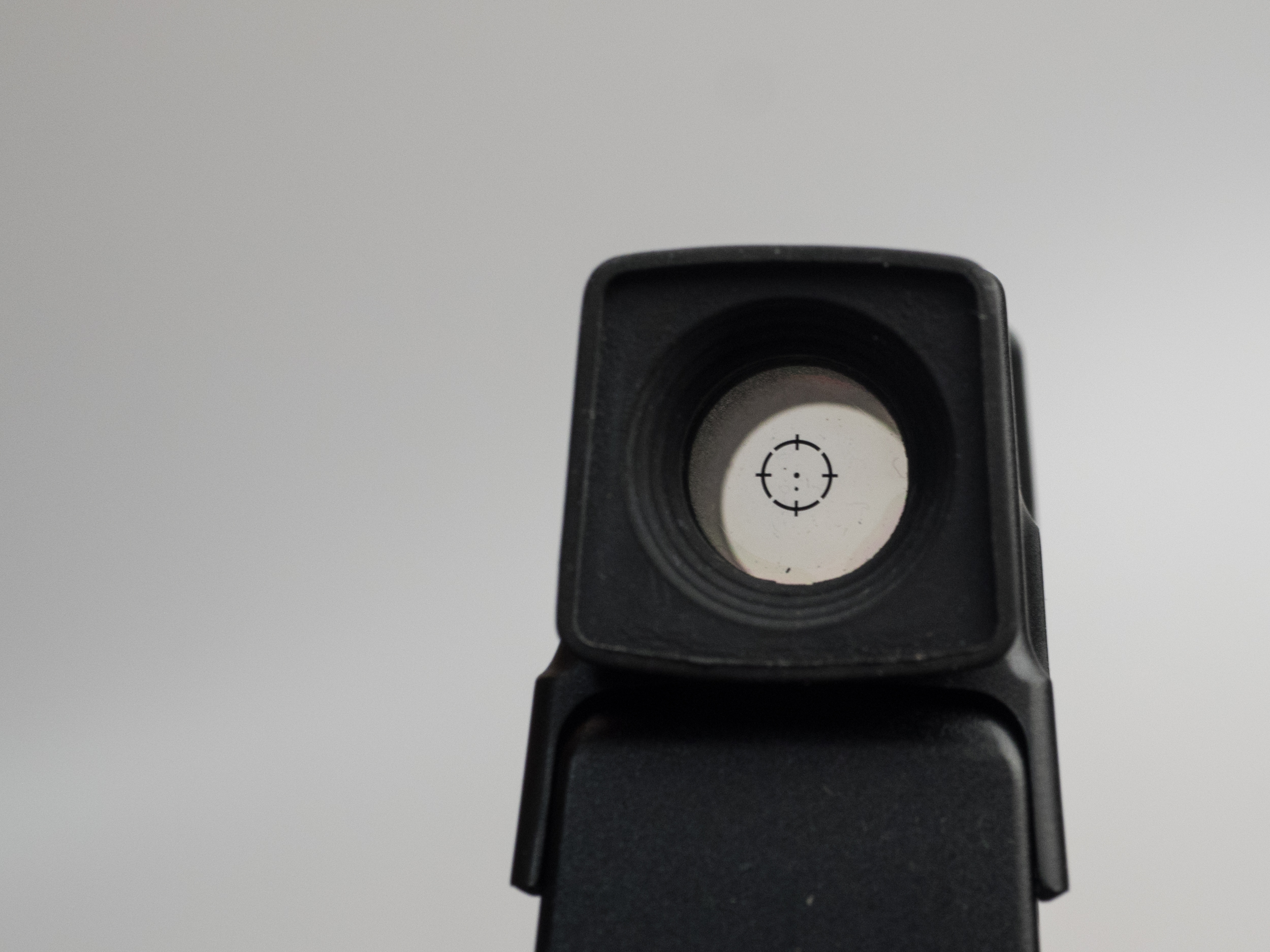
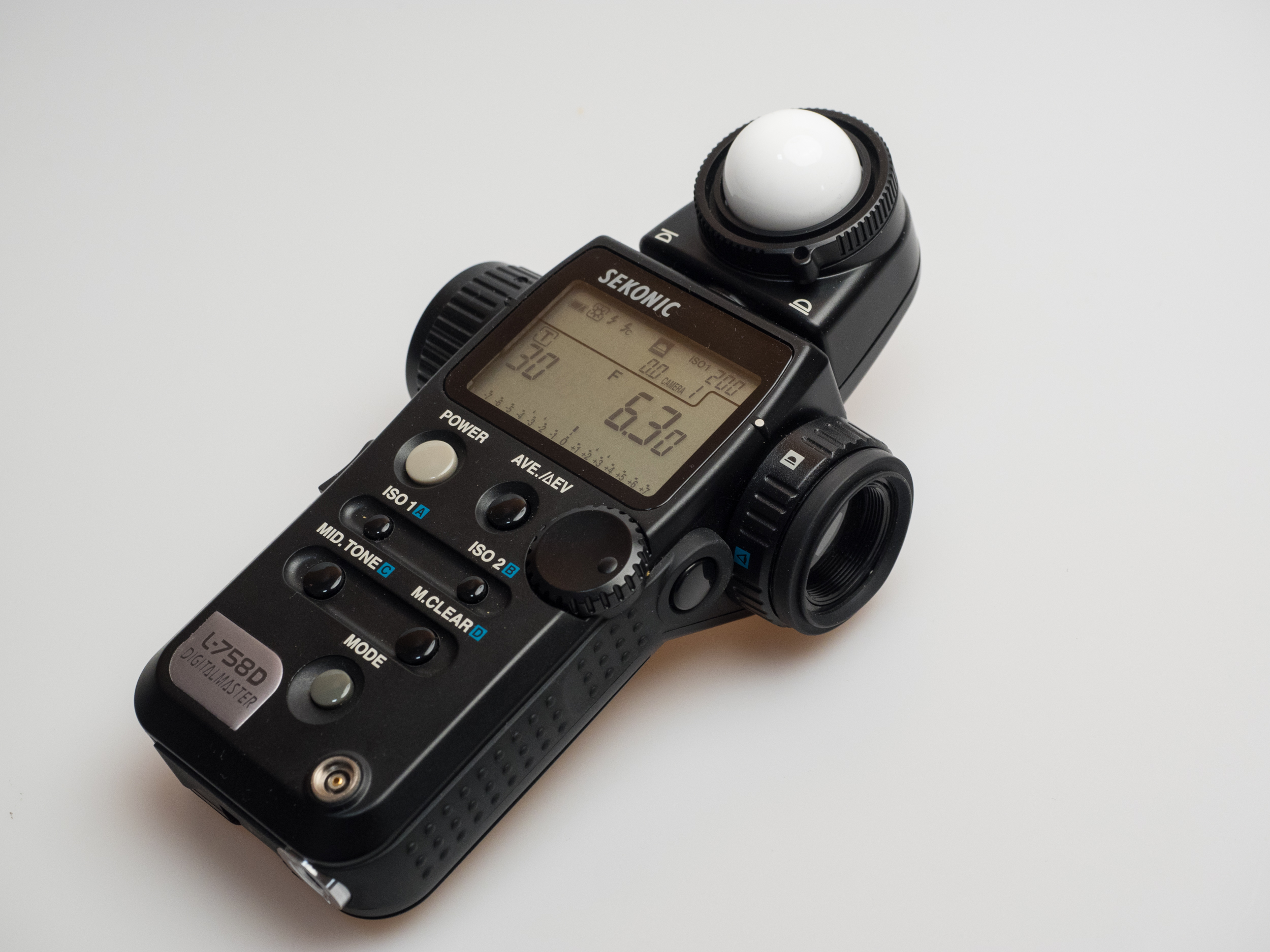
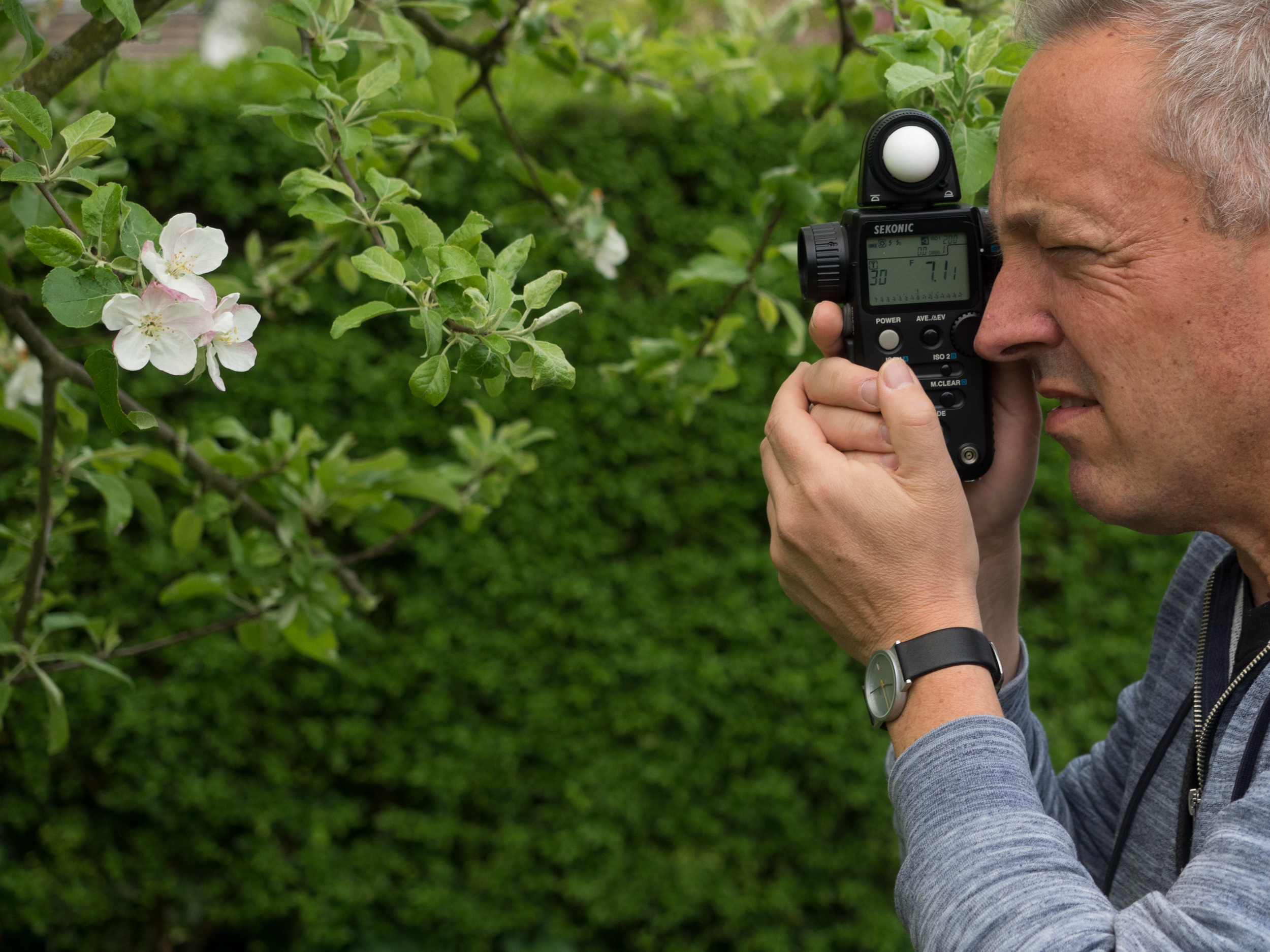
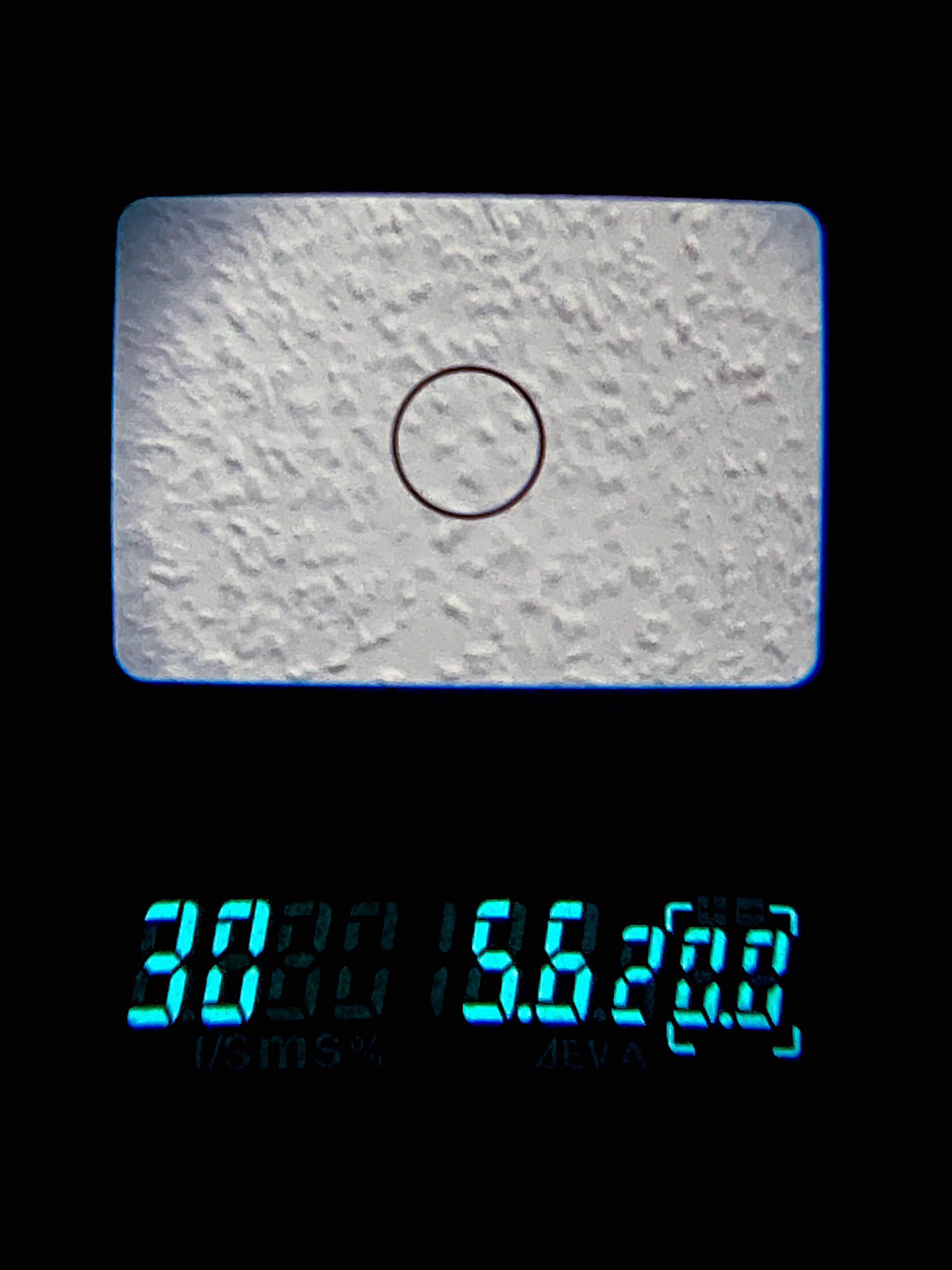
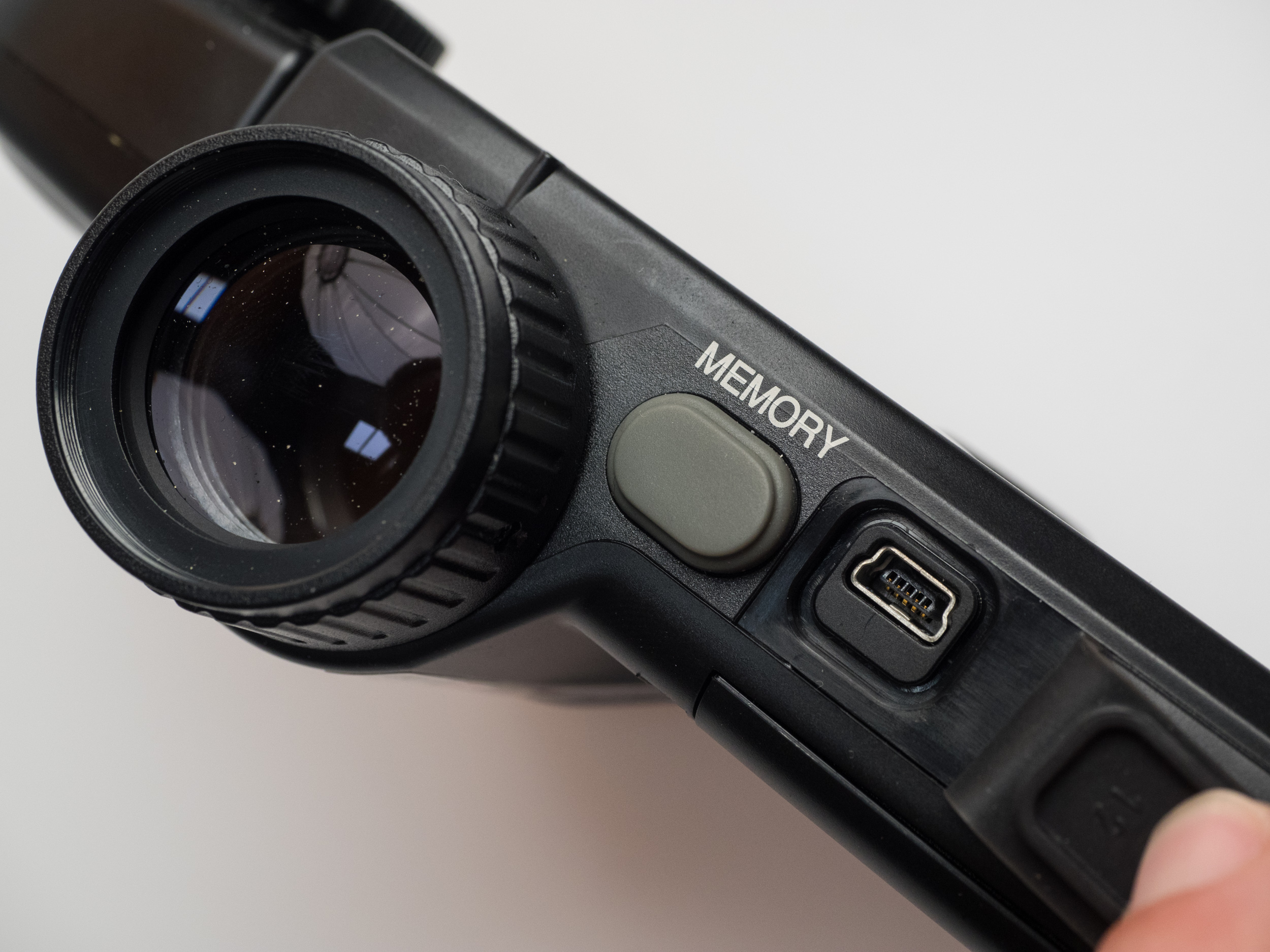
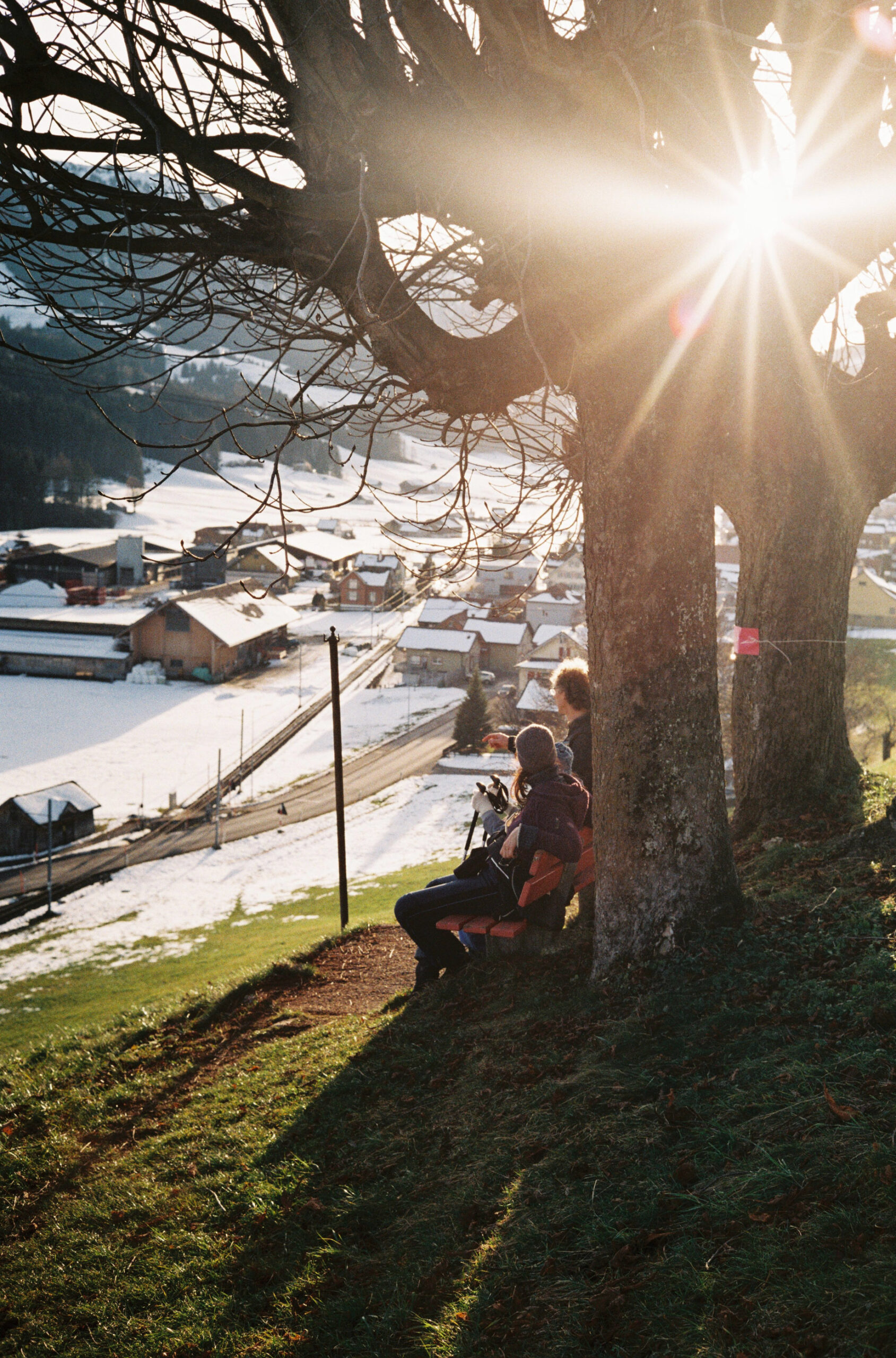




My go to meter is a Gossen Digipro F – similar sensor and readout to the Variosix/Lunastar, different button arrangement, slimmer body, smaller more common battery (AA – that seems to never wear out). Has the same annoying fractional f-stop read-out – this is mitigated somewhat by referencing the f-stop scale to observer index location relative to the full stops – like a small version of a legacy analog scale). Also meters flash. Seems to be available new in the “F2” version.
Another favorite, and my main meter before the Digipro is the Calculite XP – one of the most sensitive photography meters ever, in a compact body with a large traditional exposure dial. Had accessories for different light acceptance – for example a 5 degree zone (aimed with a compact gun sight style device) and a rotating 90 degree incident sphere – I rigged both of these on the turret to allow quick changes. Need to use a different index on the exposure dial depending on whether using reflected or incident. I shifted to the Gossen because it is slimmer a usually quicker to use, though for very low light the Calculite is better.
Finally, for something very different and quick, but less compact, the Minolta Autometer or Autometer 2. No needs or digital read-out – the traditional exposure dial is motorized and turns when the measure button is pressed. Very precise and sees rugged.
Dear Jörg, many thanks for the great article. One on hand practical and on the other hand in-depth. I’m a bit late to reply, but I’ll do it anyway 😉
First a question: how did you measure the great Appenzell backlight photo? Maybe by incident metering from the subject (couple and tree) towards camera, and then averaging that with a reflective metering towards the sun?
Then about the Gossen Variosix F2 that I have, inc. spot meter attachment. I like it a lot for incident, flash and spot metering. I also use yellow and orange filters a lot, so the easy filter compensation function is really very handy (I must say, the measured compensation does depend on the background when it is measured). Indoor flash is also very easy and precise.
The most valuable aspect of this light meter is that it ‘connects’ all the light meters of my analogue cameras. With the Gossen, I realised some are quite off (e.g. the old selenium meter of my Olympus 35SP), and some are actually very accurate (e.g. my Nikon FM3A). Of course, some cameras don’t have a light meter (e.g. my Mamiya M645 1000S). Also, for developing my B&W film, I calibrated the film ISOs (pull 1 stop, box and push 1 stop) and developing times to achieve a film density of about D1.3 at Zone VII, and without a good light meter, this is practically impossible to achieve.
Two remarks:
One thing I don’t like about is that the decimal value read-out is only for the aperture value (not for the shutter speed value), because I normally pre-choose my aperture for a scene, e.g. f/5.6 for optimal lens performance with a portrait, sometimes f/2.0 or f/2.8 for a nice fore- or background unsharpness, or f/11 (maybe even f/16) for the largest depth-of-field in a landscape photo. On my analog cameras I cannot set the shutter speed in between full stops. So unless I chose to use in-between aperture values (which is easy with Nikon AI-s lenses) I’m normally 1/3 or 1/2 stop off from what the Variosix F2 tells me. Even so, I would like to see the decimal values for the shutter speed while going through whole-stop aperture values.
Also, what I find a bit confusing with the Gossen F2 Variosix is the contrast reading with the spot meter attachment. The contrast is shown in aperture values, with the shutter speed indicated for the first measured aperture (this corresponding aperture is then blinking). So, when I do this, I have to remember to not start measuring in the shadow (Zone II or III) or highlight (Zone VII or VIII), but in the middle (ideally Zone V), otherwise the shutter speed indicated is the one that is valid for either the shadow or the highlight, and then I would have to count EVs up or down in order to find Zone V.
So I do think the Gossen Variosix F2 is a very capable device: it does practically anything a lightmeter can and should do. However, not all functions are completely in line with my own way of doing photography. Also, I feel that I’m using incident meter readings more and more: when there is uniform light it is very precise. For this reason I am interested in finding a good second hand Gossen Lunasix F which I can dedicate as incident meter: just to have a small lightmeter in my pocket or hanging around my neck, and to dedicate the Variosix F2 as spot meter.
Kind regards,
Rogier van Oostrom
Rotterdam, The Netherlands
Thanks, Rogier, and sorry for replying so late. Good to read that the effort pays off with readers who benefit from the article. If I remember well, the Appenzell image was shot with incident light metering from a Sekonic L-208 Twinmate. I remember the walk in the Swiss mountains quite well, it was my first outing with the Leica CL. But I have to admit it was also luck. When I saw the scan for the first time, I thought: Wow.
The Variosix F2 is an excellent tool, and I hope you can use it for many years to come. I agree with the points you are raising. The Variosix F2 is deeply rooted in the analogue age when cameras usually only had full stops in the exposure value scale. Of course, there were (and still are) workarounds with exposure correction or ISO manipulating. I have not so much experience with the F2’s spot metering function. My main analogue camera was an Olympus OM-4 with its excellent multi-spot metering. I think it is the best metering method in a camera I have ever seen because you can control it (other than matrix or other metering methods). This also saved me diving deep into the zone system. All the more I am in awe for your obvious knowledge in this area.
Best wishes, Jörg-Peter
I inherited a Gossen Lunasix 3 with leather case. The battery cover seems seized–it has not been used in decades–any suggestions? Thanks.
Hi David, maybe battery acid has leaked. This would be bad news because the circuits inside might be damaged as well. Try it an oil-free spray tool cleaner. It might solve the dried acid, and you can lift off the battery case cover. Otherwise a scalpel could help. JP
Late to this article, but here goes anyway.
I have had a love affair with Sekonic meters as long as I can remember. I always knew that Gossen was a superb meter, but I just prefer the look and operating methods of Sekonics. I have L228, L398, L428, L438, and L256. (Plus a collection of older Sekonics just for fun) The only Gossen is an old Sixticolor. Still works well.
My favorite is the L398, which I like for the direct-reading slides. I have two sets of these, and they are different. One set is like the one pictured, with 11 numbered slides. The little instruction sheet (a corner of which can be seen in the photo) tells you which one to use with specific shutter speed/ISO combinations, in order to read the f-stop directly on the meter. The other set, which I believe is older, has 9 slides, and instead of being numbered, the shutter speed /ASA (ISO) combinations are printed directly on the slides. It is used in the same manner.
I believe the Lunasix F uses a Silicon Blue Cell instead of a CdS cell. In the U.S. the Lunasix F was called the Luna-Pro SBC and had a blue center dial. The Silicon Blue Cell models had the zero point meter; the older Luna-Pro (no SBC) did not have the zero meter and used a CdS sensor. Those calculation dials typically had a CdS notation on them as well.
This might be a longshot, but I was wondering if you might know what could cause a Sekonic L-208 to not hold an exposure value, but rather the needle drifts up toward the top of the scale? If I hold the button down, it’s fine, but then it’s metering continuously, and I have to be careful not to aim it elsewhere while matching the needles. I’ve had it for a few years so I know it’s out of warranty, and I don’t know whether service is even possible.
I use incident light measurement most of the time; as a matter of fact except for TTL cameras I can’t remember the last time I used a reflective light meter. I like the Sekonic L428, an analogue meter, and have used them for years. I also have an Aspen Polaris (which I understand is hard to find my new these days) which is digital readout and will also serve as a flash meter. But I like the L428 best.
In the past I used the Sekonic L28, which is like the L398, both derived from the Norwood Director, but the L428 is far more sensitive.
That’s great, Paul, incident light metering makes a lot of sense. In obecjt metering, any modern camera will be as good as the best hand-held meters. I never came across the L428 but it seems to be a very good choice. As to the Polaris, there seems to be a new edition of this classic but appears to be very different from the original model. Maybe there is a chance to use either of them one day. JP
Well, now you made me go and dig up both my Lunasix F and Variosix F from their long hibernation… I used them both with my Hasselblad 20 years ago (but I much preferred the Luna with its useful dial, despite the bulk). I´ll have to get some fresh 9 V batteries, though; the only ones in the house now are used in the smoke detectors…
The latitude for correcting raw files in Lightroom has gradually made me more sloppy with exposure than I could get away with in silver days. Could be worth a try to restore the old order… And your post is a good push in that direction!
I’m glad to read this, Per.
These Gossen meters are two nice ones and I hope they have sprung to live without any trouble. The Lunasix offers excellent handling, I can only agree on this one. The zero-point operation is a superbe invention, and it shows how seriously they worked at Gossen (or better work: I guess they still have a very high level of perfection).
The huge dynamics of modern sensors certainly to make exposing easier, and I do not see so much sense in using a light meter for work with a digital camera (you have your historgam and work with it if you know its inherent limitations, you have clipping warnings, waveform monitor for videos… and of course the opportunity for on-site-checking).
Funnily I also had to dismantle a smoke detector to check if my good old Variosix F is still working. Now I have some spare 9 V batteries again.
Best, JP
Many thanks for your valuable assessments and comparisons. Looking forward to part III.
Dear Burt, you’re welcome. Part III will appear in the next few weeks. And it will comprise a huge comparison chart for all the light metering solutions I tested. I hope this will be helpful to many readers. JP